
Liberia Ministry of Health
National Malaria Control Program
Social and Behavior Change Strategy
2021-2025
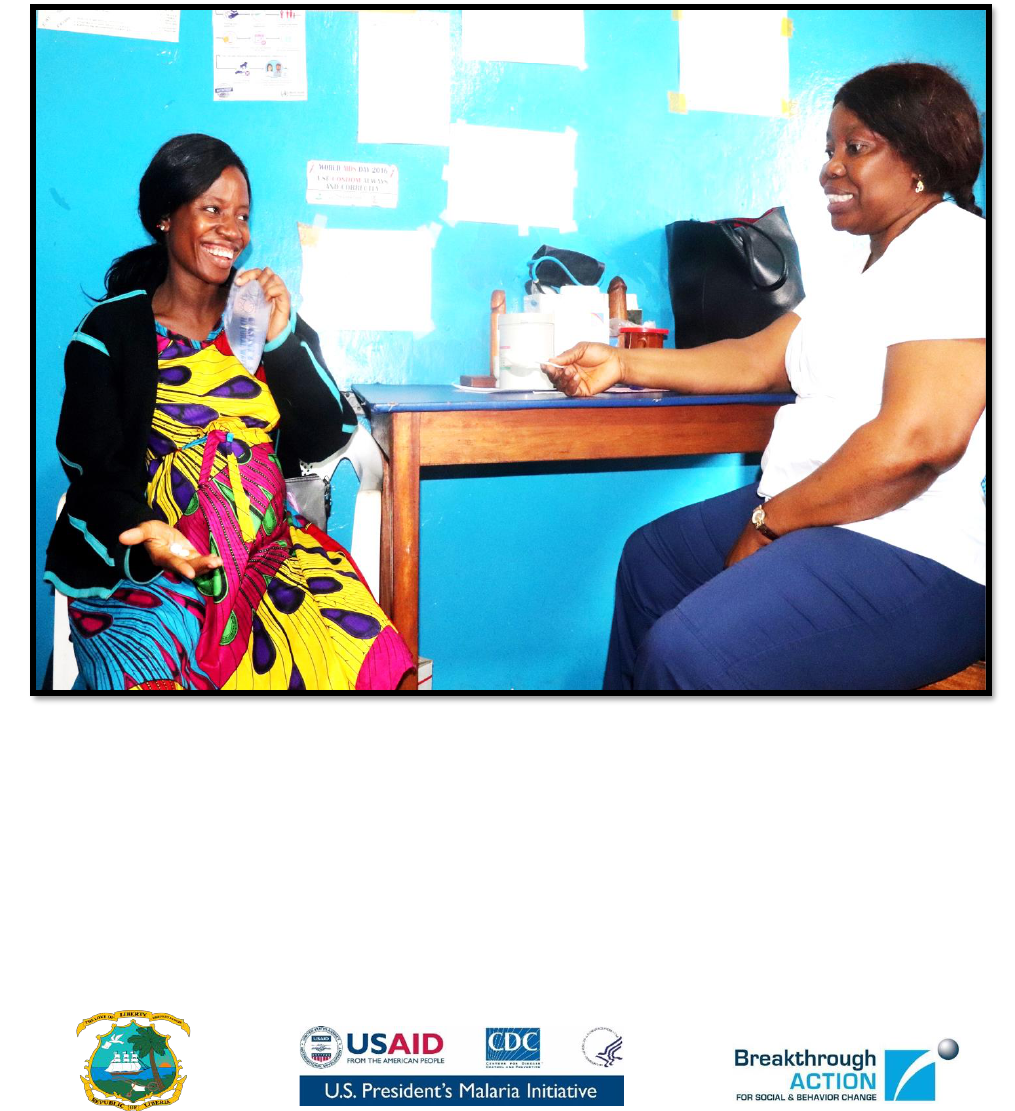
Liberia National Malaria Social and Behavior Change Strategy 2021-2025
i
The development of this strategy was made possible by the U.S. Agency for International Development
(USAID) and U.S. President’s Malaria Initiative under the terms of Cooperative Agreement No. AID-OAA-
A-17-00017 of the Breakthrough ACTION project.
A satisfied client and health service provider
Liberia National Malaria Social and Behavior Change Strategy 2021-2025
ii
Table of Contents
Foreword v
Acknowledgments vi
Acronyms viii
Vision 1
The Role of Social and Behavior Change in Malaria Prevention, Treatment, and Elimination 1
Priority Areas for SBC 2
Situation Analysis 3
SBC Strategy Objectives 4
Strengthening Coordination for Effective SBC Implementation 5
Ministry of Health “Healthy Life” Umbrella Brand 5
Proposed SBC Channels 5
Gender Integration 6
Assumptions 7
Behavior Specific SBC Strategies 9
Malaria Case Management 9
Integrated Vector Management 16
Malaria in Pregnancy 24
Monitoring and Evaluation 29
Routine /Monthly tracking of SBC activities 29
Monitoring and Evaluation Plan 30
Current Gaps in Existing SBC Data 36
Annex A: Pathways Model 37
Liberia National Malaria Social and Behavior Change Strategy 2021-2025
iii
List of Tables
Table 1: SBC to address service delivery gaps 11
Table 2: SBC Behavioral Objective 1- By the end of 2025, 75% of caregivers of children under
five years old with fever seek treatment with a provider within 24 hours 13
Table 3: SBC Behavioral Objective 2- By 2025, 95% of suspected malaria cases adhere to national
treatment guidance following a parasitological test at public/private health facilities and
community level 14
Table 4: SBC Behavioral Objective 3- By 2025, 90% of caregivers of children under five are
accessing approved anti-malarials from accredited health facilities (public/ private/ medicine
stores). 15
Table 5: SBC Behavioral Objective 4- Increase proportion of the general population with access
to ITN to 80% by 2025 18
Table 6: SBC Behavioral Objective 5- Increase the number of children under five who sleep
under ITNS to 80% by 2025 20
Table 7: SBC Behavioral Objective 6- Increase practice of correct and consistent net use among
the general population to 65% by 2025 21
Table 8: SBC Behavioral Objective 7- Increase the proportion of households that cooperate with
spray operators and follow pre-and post- spray guidelines given by spray personnel to 80% by
2025. 23
Table 9: SBC Behavioral Objective 8- Increase IPT3+ uptake by pregnant women to 80% by 2025. 25
Table 10: SBC Behavioral Objective 9- Increase consistent and correct net use by pregnant
women to 80% by 2025. 26
Table 11: SBC Behavioral Objective 10- By 2025, increase the % of pregnant girls (aged 10-19)
who utilized MIP services to 50%. 27
Table 12: M&E Plan - Malaria Case Management 30
Table 13: M&E Plan - Insecticide-Treated Nets (ITN) 32
Table 14: M&E Plan - Indoor Residual Spraying (IRS) 34
Table 15: M&E Plan - Malaria in Pregnancy 34
Table 16: M&E Plan - Cross Cutting Issues 36
Table 17: Current Gaps in Existing SBC Data 36
Liberia National Malaria Social and Behavior Change Strategy 2021-2025
iv

Liberia National Malaria Social and Behavior Change Strategy 2021-2025
v
Foreword
The Liberia National Malaria Strategic Plan (NSP) 2021–2025
1
redefines the strategic direction and focus
of the malaria program, including strengthening of management and coordination structures, health
systems, and capacities to achieve greater equity, coverage, quality, and more effective delivery of the
interventions. In addition, the malaria NSP includes plans for preparedness and timely response during
emergencies to ensure malaria control activities continue with minimal disruptions in an emergency
(e.g., Ebola Virus Disease or coronavirus).
As the first National Malaria Social and Behavior Change Strategy for Liberia, this document is intended
to guide all social and behavior change efforts supporting the objectives outlined in the NSP.
The participatory strategy development process involved partners of the Ministry of Health (National
Health Promotion Unit (NHPU), the National Community Health Services Program (NCHP), the NMCP,
Family Health Program (FHP) at the national and subnational levels, donors, non-governmental
organizations, and international partners.
Francis N. Kateh, MD, MHA, MPS/HSL, FLCP
Chief Medical Officer- RL/ Deputy Minister of Health Services
Minister of Health
Republic of Liberia
1
National Malaria Control Program, 2020; Malaria National Strategic Plan 2021-2025; Ministry of Health, Liberia

Liberia National Malaria Social and Behavior Change Strategy 2021-2025
vi
Acknowledgments
The Ministry of Health, through the National Malaria Control Program, appreciates the contributions of
the following partners in developing the National Malaria SBC Strategy (2021-2025):
• USAID
• The U.S. President’s Malaria Initiative
• The U.S. Centers for Disease Control
• Global Fund
• World Health Organization
• Johns Hopkins Center for Communication Programs- Breakthrough ACTION Liberia
• Chemonics - Global Health Supply
• Jhpiego - Strategic Technical Assistance for Improved Health Systems Performance and Health
Outcomes
• Chain- Procurement Supply Management
• Plan International - Scaling up malaria prevention and control interventions through all sectors in
Liberia for sustained universal impact
• ICF- PMI Measure Malaria
With technical assistance from Breakthrough ACTION Liberia, the National Malaria Control Program led
the development of this strategy. Government officials, technical leads, and partners who contributed to
the final review and edition of this strategy include:
National Malaria Control Program- Central
Daniel Somah, Victor Koko, Joseph Alade, Jamesetta
Smith, Agnes Nador, Agnes Janafo, Chrispin Williams, D.
Levi Hinneh, Odell Wannie Kumeh, Oliver E Pratt
County Health Teams- Malaria focal persons
Habakkuk Kollie, Mona Peters, Eunice Nyemah, Frederick
Yarsiah, Tina Summerville, Randoh Weah, Christiphus
Wolobah, Amelia Sarmu, Joyce N. Hallowanger and
Joseph Y. Newah
National Health Promotion Unit
Korto Suakollie, Lahannah Ville- Jawara, Geraldine
George, Shadrach Bestman
County Health Team- Health Promotion
Focal Person
Roseline Clark
SBCC Core Team
Queenie Nah, William Karloweah
National Community Health Program
Hawa Gboyah, Asatu Dono
Family Health Division
Jemimah Brown, Bentoe Tehoungue and Mbah Jusu
Fixed Amount Reimbursement Agreement
Garmetta Tokpah- Brown
CHEMONICS
Ibrahim Dukuly

Liberia National Malaria Social and Behavior Change Strategy 2021-2025
vii
PMI Measure Malaria
Eric Diabolo
USAID/ President’s Malaria Initiative
Jessica Kafuko, Mamadou Diallo, Miatta Sonkarlay Joejoe
Strategic Technical Assistance for Improved
Health System Performance and Health
Jethro Zawolo
World Health Organization
Vachel Harris Lake, Moses K Jeuronlon
Last Mile Health
Lekilay G. Tehmeh
Breakthrough ACTION Liberia
Lindsey Leslie, Teah Doegmah, Meata Freeman, J. Ben
Kitson, Anna McCartney Melstad, Micheal Toso, Eric
Filemyr, Tyler Best, Saratu Olabode-Ojo
Liberia National Malaria Social and Behavior Change Strategy 2021-2025
viii
Acronyms
ACT Artemisinin-Based Combination Therapy
CHA Community Health Assistant
CHT County Health Team
CHV Community Health Volunteer
DHT District Health Team
FARA Fixed Amount Reimbursement Agreement
GTS Global Technical Strategy
iCCM Integrated Community Case Management
IPTp Intermittent Preventive Treatment for Malaria in Pregnancy
IRS Indoor residual Spray
ITN Insecticide-Treated Net
IVM Integrated Vector Management
LDHS Liberia Demographic and Health Survey
LMIS Liberia Malaria Indicator Survey
MBS Malaria Behavioral Survey
MOH Ministry of Health
mRDT Malaria Rapid Diagnostic Test
NCHP National Community Health Services Program
NMCP National Malaria Control Program
NSP National Malaria Strategic Plan
PBC Provider Behavior Change
PMI U.S. President’s Malaria Initiative
RBM Roll Back Malaria
SBC Social and Behavior Change
SMS Short Messaging Service
S.P. Sulphadoxine pyrimethamine
STAIP Strategic Technical Assistance for Improved Health System Performance and Health
Outcome
TTM Trained Traditional Midwife
WHO World Health Organization

Vision
The vision of the National Malaria Control Program is a malaria-free and healthy Liberian population.
The National Malaria SBC Strategy (2021-2025) outlines social and behavior change approaches that
focus on improving critical areas of malaria prevention and treatment to support the vision of the
National Malaria Control Program. No person should die or suffer from malaria, a preventable disease.
The Role of Social and Behavior Change in
Malaria Prevention, Treatment, and Elimination
Social and Behavior Change (SBC) is a strategic design-thinking process that integrates different
methodologies (e.g., advanced audience segmentation, behavioral science, strategic communication,
and community mobilization) and develops solutions tailored to each unique behavioral challenge. SBC
approaches seek to understand individual, social, environmental, and structural determinants that drive
audiences to achieve positive health and development outcomes. Interventions are cross-cutting and
are applied across all domains of malaria control programs to support desired outcomes. As such, the
integration of SBC interventions into strategic malaria plans is crucial for eliminating the disease
2
.
There are many social and behavioral barriers to the acceptance and use of malaria preventive
measures. More effective strategies can be developed through an improved understanding of these
behavioral factors and how they influence exposure to malaria. This strategy outlines evidence-based,
theory-driven approaches that can positively influence malaria prevention and treatment behaviors.
Further, by taking a systems-based approach, including advocating for improved coordination and policy
change, this strategy aims to contribute towards Liberia’s malaria elimination efforts.
SBC encompasses more than communication. Human behavior is influenced by several subconscious
biases, contextual factors, and psychological or mental "shortcuts" that do not always represent a
rational, logical pathway. SBC must evolve and change to meet the complexities presented by human
behavior. This strategy will draw on advances in the field, such as human-centered design and
behavioral economics, to design messages and interventions that reflect the behavioral nuances of a
target population. Enhanced audience segmentation through audience profiles (personas), empathetic
engagement of end-users, and critical review of the behavioral patterns that emerge from data on
current malaria behavior will strengthen the SBC approaches outlined by NMCP to achieve stated
malaria goals.
Hence, this strategy takes into consideration several important factors which influence individual as well
as interpersonal (provider-client) and community-level behaviors (for example, local perceptions of
malaria and its causes; household-decision making; patterns of treatment-seeking behavior during
episodes of malaria; the role of the community in implementing malaria prevention and treatment
measures; resource and time constraints; gender norms; religious and traditional beliefs; and social
2
The Strategic Framework for Malaria SBCC: 2018-2030

Liberia National Malaria Social and Behavior Change Strategy 2021-2025
2
norms). All these factors play a significant role in determining commitment to consistent practice
malaria preventative behaviors at the individual, household, and community levels.
Behavioral models are critical to developing informed, relevant, and effective SBC interventions to
eliminate malaria. Liberia's National Malaria Communication Strategy (2016-2020) drew upon the
Pathways Framework
3
and included elements of several theories of behavior change. This strategy
updates the Pathways Model, which is an integrated model of behavior change. The updated model
reflects current realities related to individual attitudes, beliefs, practices, social structures, the
environment, and gender. For more details, see appendix A: Pathways Framework.
Priority Areas for SBC
This strategy focuses on applying SBC approaches to influence knowledge, attitudes, practices, and
outcomes in three areas known to contribute towards malaria prevention, treatment, and elimination
effectively:
Malaria Case Management
• SBC will focus on care-seeking behaviors, as well as communication gaps among clients and service
providers before, during, and after care, especially those related to parasitological testing of all
suspected malaria cases before treatment, and adherence to treatment in line with NMCP technical
guidelines, based on the World Health Organization (WHO) 3-T’s (Test, Treat, and Track).
• SBC can support awareness among individuals, providers, and communities on the availability and
risks posed by substandard and counterfeit antimalarial medicines.
Integrated Vector Management
• SBC will focus on the demand for ITNs to increase the acquisition of nets during mass distribution
and continuous distribution efforts.
• SBC will address communication gaps related to care, misuse, and beneficial net repurposing while
establishing a culture of consistent, year-round use by all Liberians.
• SBC will focus on knowledge and acceptance of Indoor Residual Spraying (IRS) and larvicides.
Malaria in Pregnancy
• SBC will support Liberia's updated technical guidelines for malaria case management and malaria
in Pregnancy (2020), which follows WHO recommendations on timing, frequency, and dosage
protocol for intermittent preventive therapy for malaria in pregnancy (IPTp), to promote a
minimum of 3 doses of IPTp.
3
Kincaid DL, Figueroa ME, Underwood C. Pathways

Liberia National Malaria Social and Behavior Change Strategy 2021-2025
3
Situation Analysis
Malaria is endemic in Liberia. It poses a risk to the entire population year-round, especially pregnant
women and children under five (the 2019-2020 DHS lists as particularly vulnerable).
Knowledge and perceptions of malaria prevention are high in Liberia. According to the Liberia 2016
Malaria Indicator Survey (MIS)
4
, 58% of women surveyed had seen or heard a malaria message in the
past few months; among them, the most common messages are those about bed nets, such as 'use your
mosquito net' (98%), 'everywhere, every night, sleep under the net' (96%), and 'hang up, keep up' (57%).
Other messages were also reported by a large majority of women exposed to the malaria message: ' if
you have fever, go to the health facility' (93%), and 'pregnant women should take drugs to prevent
malaria' (91%).
According to the 2019-20 Liberia Demographic and Health Survey (LDHS), 55% of households possess at
least one Insecticide Treated Net (ITN). However, according to the 2019-20 DHS, only 40% of the
population had access to nets. In fact, 45% of households did not have any net, and another 30% did not
have enough nets to cover at least one net for two people.
5
ITN access, use, seasonal temperature variations, and rainfall can lead to shifts in net use over a year.
Among those who have access to a net in the 2019 DHS, use is 98% (78% for pregnant women).
However, pregnant women and most children under five are not regularly sleeping under ITNs. Over half
of all pregnant women surveyed (53%) did not report sleeping under an ITN. This trend held in children
under five (56%). Given that 98% of people with access to a net use them, access to nets must be
increased.
Fever is a primary clinical manifestation of malaria, although it is also a symptom of other illnesses.
According to the 2019 LDHS, a quarter of children (25%) under five had a fever during the two weeks
preceding the survey. The percentage of children with a fever was slightly higher among rural areas than
in urban areas (27% and 24%, respectively). Advice or treatment was sought for 81% of children with a
fever, and almost half (49%) had blood taken from a finger or heel for testing.
Nearly 90% of women with a live birth in the two years preceding the survey reported taking at least
one dose of sulphadoxine-pyrimethamine (S.P.) for intermittent preventive treatment in pregnant
women (IPTp), 70% received two or more doses, and 40% reported taking three or more doses. In
4
Liberia 2016 Malaria Indicator Survey (MIS)
5
Liberia Institute of Statistics and Geo-Information Services (LISGIS), Ministry of Health and Social Welfare [Liberia], and ICF. 2020. Liberia
Demographic and Health Survey 2019-20: Key Indicators. Monrovia, Liberia, and Rockville, Maryland, USA: Liberia Institute of Statistics and
Geo-Information Services (LISGIS), Ministry of Health and Social Welfare, and ICF.
Liberia National Malaria Social and Behavior Change Strategy 2021-2025
4
addition, the IPTp3 trend indicates an increase from 11% in 2011 to 23% in 2016 and 40% in 2019 (2019-
20 DHS. Thus, despite the increase in IPTp uptake, there is room for improvement.
SBC Strategy Objectives
The National Malaria SBC Strategy (2021-2025) contributes towards goals and objectives outlined in the
National Strategic Plan 2021–2025. In addition, the strategic objectives are informed by the National
Health Promotion Policy and Plan and the National Communication Strategy (2016-2021). This malaria
SBC strategy also reflects the goals of the WHO High Burden to High Impact strategy and WHO’s Global
Technical Strategy (GTS) 2016-2030, the Roll Back Malaria Partnership to End Malaria (RBM), and the
U.S. President’s Malaria Initiative (PMI). The RBM Social and Behavior Change (SBC) working group’s
strategic framework and PMI’s global strategy also served as important guidance documents.
The National Malaria SBC Strategy (2021-2025) contributes towards goals and objectives outlined in the
National Strategic Plan 2021–2025. The SBC-specific strategy objectives include:
At the Individual Level:
• To maintain high levels of knowledge (98%) related to malaria, including prevention behaviors
• To increase nightly net use to 65%
• To increase the proportion of individuals who adhere to treatment based on test results (quality
medicines prescribed by recognized medical providers) to 70%
At the Household Level:
• To maintain the proportion of the general population who correctly and consistently use the net
(once accessed), currently at 98%
• To increase household acceptance of IRS to 85%
At the Community Level:
• To increase the proportion of children and pregnant women who seek quality malaria
preventative services, specifically, access to nets, to 75%
• To increase the proportion of pregnant women who seek quality malaria preventative services at
least three times (IPTp3+) during ANC visits to 70%
At the Service Level:
• To increase the proportion of the population who seek prompt care for a fever to 75%
• To increase the proportion of people who demand a test to 80%
• To increase the proportion of caregivers for children under five with recent fever who receive
anti-malarial drugs to 90%
• To increase IPTP rates and net access among pregnant women by ensuring providers adhere to
clinical guidelines
Liberia National Malaria Social and Behavior Change Strategy 2021-2025
5
Strengthening Coordination for Effective SBC
Implementation
Each of the stated SBC priority areas involves a range of actors within the Government of Liberia and
external partners. SBC efforts can only realize their full potential for improving results with improved
coordination at the national and sub-national levels. A shared agenda for SBC and clarity on the roles
and responsibilities are critical to effectively implementing this strategy and fully achieving the
objectives.
While the NMCP is responsible for providing leadership, coordination, and strategic direction for
operationalization of the strategy, effective collaboration with other multi-sectoral stakeholders at all
levels will ensure strategy implementation and scale-up results in high-quality malaria prevention, care,
and treatment efforts across Liberia. Through regular coordination meetings, message harmonization
efforts, information sharing, joint monitoring, and other coordination efforts, the SBC efforts outlined in
this strategy will reach the outlined objectives. Therefore, this strategy aligns with the coordination plan
outlined and discussed in the National Malaria Strategic Plan 2021-2025. In addition, it is expected that
all stakeholders, implementing partners, and donors will actively participate in providing technical and
funding support as appropriate and support the implementation of the SBC interventions to support
congruent thematic areas as outlined in the National Malaria Strategic Plan 2021-2025, the National
Communication Strategy (2016-2021), the National Health Promotion Policy and Plan.
Ministry of Health “Healthy Life” Umbrella
Brand
The Ministry of Health developed the “Healthy Life” brand as an overarching symbol and a unifying
identity for Liberia’s revitalized health system for all health-promoting activities, materials, and
messages. The MOH’s umbrella logo will be included in SBC media, materials, and messages to align with
the MOH efforts to engage all units in promoting a Healthy Life. This brand approach effectively impacts
social norms and emphasizes a community value about everyone’s responsibility in preventing malaria
transmission for a “Healthy Life.”
Proposed SBC Channels
An array of SBC channels will be used to reach the primary audience, including:
• Umbrella “Healthy Life” campaign (see above MOH Healthy Life Umbrella campaign).
• Health talks are facility-based short presentations that are often health-focused. Talking points and
visual aids should guide the talks.
• Radio is a top source of information on malaria in Liberia; before airing audio content, there should
be a clear strategy including the type of content, proposed frequency/timing, anticipated timeline,
monitoring plans, and, eventually, a mechanism for evaluating impact.
Liberia National Malaria Social and Behavior Change Strategy 2021-2025
6
• Print materials that are understood by a broad audience, durable to withstand the elements, and
relevant.
• Real Stories Use examples and testimonials of real people to highlight the benefits of the intended
behavior.
• SMS messages with information and motivation can be blasted to mobile phones regularly,
reinforcing practices using cues to action.
• Social media platforms refer to internet-based programs such as Facebook.
• Community outreach, including community drama, Video Clubs, advocacy and sensitization
meetings, town halls, town criers, marketplaces, and dialogues.
• Door-to-door mobilization to deliver messages concerning IRS with social mobilizers who can
disseminate information to communities on when and how households should prepare for IRS
before, during, and after the spraying exercise.
• Advocacy and town hall meetings with communities and community leaders will disseminate
information on SBC activities and address rumors and misconceptions around SBC activities.
• Faith and community leaders- Town chiefs, women's clubs, youth clubs, health committees,
traditional leaders, school health clubs are potential behavior change agents that can promote
malaria prevention and control.
• Service providers are trusted sources and can help disseminate information as part of routine care.
In addition, they can engage in multiple forms of health promotion, including facility visits, health
talks, home visits, and outreach by community health workers (CHAs, CHVs, TTMs, etc.)
• Pre-service and in-service training is an opportunity to integrate key malaria SBC messages focused
on service provider attitudes, self-efficacy, perceived risk, and social norms.
• Job aides could clearly outline national guidelines in an easy-to-use format.
• Cues to action challenge SBC implementers to examine existing behaviors the key audience does
well and identify potential avenues for leveraging those existing habits (as cues) to
• encourage the uptake of preventative malaria behaviors.
• Schools can incorporate malaria awareness and control as health education topics, including
dangers associated with malaria and key preventative actions they should take, including ITN use
and care.
• School health teachers and nurses can also raise awareness of malaria prevention and treatment
through class educational activities.
• Mass distribution should encourage registration, raise awareness about the time and location of
distribution points, encourage people to obtain and offer options for replacing nets either in the
private sector or through routine distribution channels.
Gender Integration
SBC activities, including malaria SBC activities, should consider gender for effective programming. This
strategy will prioritize the integration of gender across all priority areas of this activity. According to the
LDHS 2019-2020, 69% of currently married women participate in all three specified household decisions
either alone or jointly with their husbands, and 12% do not participate in any of the three decisions. SBC
activities will improve household gender dynamics related to malaria through increased support during
pregnancy (emotional support, accompaniment to health services, transportation, and domestic
responsibilities), including seeking care and support for children under five.

Liberia National Malaria Social and Behavior Change Strategy 2021-2025
7
In addition, this strategy will highlight areas for increased male involvement within the priority areas of
malaria case management, integrated vector management, and malaria in pregnancy. For example, this
strategy may materialize as a shared responsibility, joint decision-making during fever case seeking,
advocating for ITN use every night, or male partners providing support for pregnant women.
The Malaria National Strategic Plan (2021-2025) cites a 2018 process evaluation report
6
finding that
adolescents face unique barriers, particularly pregnant girls. These barriers include:
• being frequently unable to access health facilities independently (as health staff requires the
presence of an adult),
• shame related to their pregnancy,
• poor adherence and refusal to access resources often requiring extensive follow-up from
healthcare workers,
• lack of social support due to absent fathers of their babies, and
• language barriers at the health facility. Considering the impact of gender in malaria, SBC can assist
in overcoming these barriers.
Assumptions
This strategy is based on the following assumption:
• Data: An evidence-driven, theory-informed strategy requires comprehensive and recent behavioral
data. This strategy focuses on SBC interventions based on available behavioral, demographic, and
epidemiological data. The assumption is that newer data will become available over the next five-
year period. Breakthrough ACTION in coordination with the NMCP plans to field a Malaria Behavior
Survey in 2021, which will provide updated malaria behavioral data. As additional data becomes
available from forthcoming formative assessments, NMCP will encourage widespread dissemination
while continually reviewing all available evidence to inform the development of SBC interventions
to reflect variations across counties, audiences, behavioral determinants, and other key factors.
Regular data use activities at all levels (review meetings, bulletins, dashboard at least quarterly)
should include an analysis of data relevant to SBC efforts.
• Public Health Emergencies: Public health emergencies, infectious disease outbreaks, and other
public health risks are evolving situations that will continue to impact malaria SBC activities for the
foreseeable future. SBC is critical to preserve the previous gains in malaria prevention and treatment
and mitigate the impact of public health emergencies on the demand, utilization, and update of
malaria interventions. The assumption is that public health emergencies (e.g., Ebola Viral Disease,
COVID-19) will continue to rise in Liberia and may impact malaria SBC activities for the foreseeable
future. For example, emergency preparedness did not change the importance of social mobilization,
but it has impacted how mobilization efforts were operationalized during the COVID-19 outbreak.
NMCP, in consultation with partners, will guide how the continuation of routine SBC malaria
6
Process Evaluation Report, Plan International, 2018
Liberia National Malaria Social and Behavior Change Strategy 2021-2025
8
activities during public health emergencies. NMCP will also support efforts to track, monitor,
manage, and mitigate rumors that may emerge related to public health emergencies.
• SBC Capacity: Successful implementation of this strategy depends on trained and experienced SBC
practitioners to support such activities at the central, county, district, and community levels. The
assumption is that NMCP will identify opportunities to continue strengthening existing structures to
contribute to the planning, design, development, implementation, monitoring, and evaluation of
this National Malaria SBC strategy. For example, capacity assessments to capture SBC knowledge
and skills and develop future training opportunities or developing a detailed message guide that
includes harmonized messages for malaria prevention and treatment.
• Advocacy: NMCP will continue to be a highly visible program within the Ministry of Health. The
assumption is that as NMCP leads malaria advocacy efforts, there will be requests for increased
support and coordination necessary to carry out SBC activities. NMCP will also engage other
Ministries (e. g. Internal Affairs, Education, Agriculture, Gender, and Youth) to coordinate high-quality
SBC activities for optimal results.

Liberia National Malaria Social and Behavior Change Strategy 2021-2025
9
Behavior Specific SBC Strategies
Behavior specific SBC strategies will address the following key areas: Malaria Case Management,
Integrated Vector Management, and Malaria in Pregnancy.
Malaria Case Management
At a glance: SBC efforts will support the service delivery continuum for both clients and providers in
alignment with national guidelines and treatment protocols. For example, creating demand for testing,
building trust in the results, supporting providers to align to national protocols, and ensuring clients take
a complete regimen of quality Artemisinin-Based Combination Therapy (ACTs) if prescribed.
Current Situation
According to the WHO treatment guidelines (which NMCP adopted in 2011 and recently updated in
2020),
7
every patient suspected with malaria should be assessed and tested with malaria rapid
diagnostic tests (mRDT) or microscopy and treated based on the positive test results and classification.
The NMCP adopted the WHO 3-Ts (Test, Treat, and Track) policy in 2010.
The percentage of suspected malaria cases that receive a parasitological test at public/private health
facilities is high. According to the routine health management information system-2020, the testing rate
stands at 95% for children under five. However, the population-based Malaria Indicator Survey 2016
result reported that 49% of children under five received tests for fever. Furthermore, the LDHS 2019-
2020 shows little change since 2016, as advice or treatment from a facility/provider was sought for only
48% of children the same or the next day in 2019.
8
These results are below the desired target of 95% as
per the National Strategic Plan 2021-2025.
Since the introduction of mRDTs, confirmed malaria diagnosis has increased significantly in the public
sector (currently 94%). According to the malaria case management barrier study
9
, the quantitative
findings show that of the 83 patients interviewed, 52 patients acknowledged that there were no
challenges during the course of the treatment at the facilities. However, 31 patients admitted facing
different challenges ranging from health workers' attitudes to being given a prescription because of
stock-outs. These challenges were similar to the challenges discussed by participants in the qualitative
part of the report, which mentioned poor treatment-seeking attitudes were due to stock-outs of Malaria
drugs and testing kits, unavailability of services, inaccessibility of healthcare, unaffordable services, and
health worker attitudes. A patient receiving treatment without a confirmed diagnosis is contrary to the
national guidance. In Liberia, artemisinin-based combination therapy (ACT) is the recommended first-
7
WHO’s Guidelines for the Treatment of Malaria, Second Edition (2010)
8
LDHS, 2019-2020
9
Malaria Case management barrier study
Liberia National Malaria Social and Behavior Change Strategy 2021-2025
10
line treatment for uncomplicated malaria. There are several challenges experienced at the health facility
as they administer ACTs, including limited resources, staff turnover, stock-outs, and challenges related
to compliance to treatment guidelines and adherence to treatment protocols. In line with the malaria
case management technical guidelines, all patients who test positive for malaria must be treated with
first-line ACTs. According to the recent HMIS data, 95% of patients received first-line treatment (ACTs).
Several studies show that service providers’ attitudes – not only their level of knowledge or training –
can affect the type and level of care they provide. Service provider care, specifically their interpersonal
communication towards clients, can also affect the uptake of health services, which extends to malaria
care-seeking practices. Though responsible for SBC implementation, service providers are not well-
resourced, resulting in gaps in the consistency of SBC messages, quality of SBC implementation, and
inconsistent provider behavior related to malaria testing and treatment.
Summary of gaps in case management
Nonadherence to treatment guidelines
• Health workers treating uncomplicated malaria with injectables, and treating when the test result
is negative for malaria
• Provider-client communication challenges, provider attitudes towards the patient
• Community members may elect to disregard instructions from screeners/ dispensers
Non-compliance to the treatment regimen
• Misinterpretations, lack of adherence to the instructions provided for treatment dispensed at the
health facility
• Decisions to stop treatment course pre-maturely (as soon as their health improves)
• Limited awareness and understanding of the benefits of completing treatment
Self-diagnosis and self-medication among community members
• Overall limited health-seeking behavior practices by the community
• Community members access treatment from pharmacy and medicine stores without demanding
tests
• Community members use traditional practices and monotherapy that are not recommended
(Artemeter tablet, herbs, etc.)
• Community members’ primary preference for health-seeking is usually the medicine store (MIS
2011) due to long waiting hours, stock-outs, health worker attitude.
A holistic approach to SBC for service delivery would incorporate SBC approaches for malaria case
management to address gaps as they arise across the service delivery continuum. This may include:

Liberia National Malaria Social and Behavior Change Strategy 2021-2025
11
Table 1: SBC to address service delivery gaps
Client-side
Provider-side
• Seek prompt care with a health provider
within 24 hours of first signs and
symptoms
• Be aware of a malaria test result before
receiving treatment; and build trust in
malaria test results, as necessary
• Complete course of quality malaria
medications
• Have access to affordable quality-assured
treatment, be able to identify and buy
recommended treatment according to
National Malaria control guideline
• Understand that not every fever is malaria
• Know that treatment of uncomplicated
malaria is free at public health centers
• Educate the client on the importance of testing
before treatment and disclose test results
• Provide clear instructions and benefits of
completing the full course of treatment to
patients
• Test all suspected malaria cases before treating
• Treat only parasitological confirmed malaria
cases
• Treat confirmed cases based on classification
• Track malaria testing and treatment to gauge
progress; ensure the use of quality malaria
medications
• Stock and prescribe/ sell recommended anti-
malarial according to NMCP guideline
Audience Analysis
Clients: Family and community members that assist in decision-making regarding care-seeking,
especially for children under five years of age, regardless of gender (mothers, fathers, grandmothers,
older children, and parents and guardians) must be able to observe the child's mood regularly to detect
or identify changes in the child's behavior (feeling sick, loss of appetite, etc.) and seek immediate care
when changes occur. Heads of households should serve as the support arm to the caregivers and are
usually responsible for providing resources (money) to cover/facilitate treatment for the child at the
health facility. Couples should discuss care-seeking in advance of a child's illness so that there is a plan,
including finances and logistics, to seek care promptly when a fever presents to encourage male
involvement.
Providers: The primary audience to be considered will include health facilities, pharmacies, medicine
stores, and community-based service providers who provide services for clients experiencing fever (e.g.,
Registered Nurses, Medical Doctors, Physician Assistants, laboratory technicians, certified midwives, and
CHAs/ CHVs, dispensers). At the facility level, health workers are trained to use of NMCP national
guidelines and are provided job aids to identify and manage uncomplicated and complicated malaria
cases appropriately.
At community level: Community Health Assistants (CHAs) are trained in integrated community case
management of childhood illnesses and are provided job aids to appropriately identify and manage
uncomplicated malaria cases according to NMCP guidelines and make appropriate referrals for
Complicated cases. The CHA role is critical for the timely management of uncomplicated malaria cases,
reducing the chance of progression to complicated malaria in communities beyond 5kms of healthcare
facilities.
Liberia National Malaria Social and Behavior Change Strategy 2021-2025
12
However, when complicated cases are identified CHA will administer appropriate pre-referral treatment,
properly complete referral processes, and follow the referral pathways (Community- Health Facility).
When complicated cases are identified, at health facilities where management is not possible, screeners
will be able to administer appropriate pre-referral treatment, properly complete referral processes, and
follow the referral pathways) for prompt and effective malaria case management.
Gaps identified during supportive supervision visits are expected to be addressed through onsite
coaching and mentoring. Dispensers are also critical in providing information on treatment dispensed or
prescribed at health facilities, pharmacies, and medicine stores. At facilities, they are mostly the last to
have contact with patients. In contrast, they are the first line –and often only line- of contact with
patients at pharmacies and medicine stores. Therefore, it is essential to ensure they are adequately
trained to explain instructions and benefits to patients for full compliance.
Government: MOH is an important audience for advocacy efforts as they allocate resources,
commodities, and support for malaria case management.

Liberia National Malaria Social and Behavior Change Strategy 2021-2025
13
Behavior-specific Plan
Table 2: SBC Behavioral Objective 1- By the end of 2025, 75% of caregivers of children under five years old with fever seek
treatment with a provider within 24 hours
SBC Behavioral Objective 1
By the end of 2025, 75% of caregivers of children under five years old with fever seek treatment with
a provider within 24 hours
Primary audience: Primary caregivers (e.g., mothers, fathers, grandmothers)
Secondary audience: Aunts, Uncles, Screeners, Dispensers, CHVs/ CHAs
Communication Objective 1: Increase the proportion of caregivers of children under five who know
when to seek care upon observing danger signs for malaria
Communication Objective 2: Increase the proportion of caregivers who feel confident in seeking care
within 24 hours for children under five, immediately after recognizing signs and symptoms of malaria.
Key benefit: If caregivers seek care for children with fever within 24 hours, the children will receive
treatment early and will recover quickly, be healthy and happy. Early care-seeking will also prevent
uncomplicated malaria from progress to complicated malaria and death.
Supporting points: Prompt and effective care and treatment for malaria brings economic benefits
such as reduced economic burden on household health care spending. It also prevents the child from
missing school and helps early detection of other infectious diseases that might mimic malaria
symptoms. Effective testing and treatment for malaria are free and mostly available in all public
health facilities and communities. Private facilities also have the capacity to effectively test and treat
malaria at a cost once they are trained.
Channels/ Activities:
Mass Media: Umbrella Media Campaign; Health Talks; Radio
Testimonials: Print materials; Social Media
Community: Faith and community leaders; Community Outreach including community drama, Video
Clubs, advocacy and sensitization meetings, town halls, town criers, marketplaces, and dialogues.
Service: Service providers; Job Aids
Cues to action

Liberia National Malaria Social and Behavior Change Strategy 2021-2025
14
Gender: All patients, irrespective of their sex, will have equal access to care and treatment for
malaria. Therefore, couple communication will be crucial to improving joint decision-making for their
child's health. This approach will be enhanced if partners dialogue before the child gets sick. Then, by
agreeing on the action required in taking their child/children for health care services, they can save
time and focus on seeking care. Patients will also be told that malaria care provided at public facilities
is free.
Table 3: SBC Behavioral Objective 2- By 2025, 95% of suspected malaria cases adhere to national treatment guidance following
a parasitological test at public/private health facilities and community level
SBC Behavioral Objective 2
By 2025, 95% of suspected malaria cases adhere to national treatment guidance following a
parasitological test at public/private health facilities and community level
Primary audience: Caregivers (e.g., mothers, fathers, grandmothers, older school-age children)
Secondary audience: Service Providers (Screeners, CHAs, CHVs)
Communication Objective 1: Increase the proportion of community members (especially caregivers)
who believe it is important to complete anti-malarial treatment (administered following a
confirmatory diagnosis).
Communication Objective 2: Increase the proportion of health workers who prioritize the use of
diagnosis guidelines, protocols, and reference materials at the various screening/laboratory rooms.
Key benefit: If malaria cases are identified correctly, they will receive proper treatment. For service
providers, clients will have faith in the health system, which will be a point of pride and satisfaction.
Supporting points: Clients will feel empowered and satisfied that the diagnosis was first confirmed
with a malaria test before treatment. Providers are satisfied when the caretakers demand a malaria
test before treatment. This improves the quality of services delivered in the health facility.
Channels/ Activities:
• Community: Community outreach, including community drama, Video Clubs, advocacy and
sensitization meetings, town halls, town criers, marketplaces, and dialogues; Faith and
community leaders
• Service: Health talks; Service providers; Job aids; Pre-service and in-service training
• Mass media: Umbrella media campaign; Radio; Print; Testimonials; SMS; Social media
platforms
• Cues to action
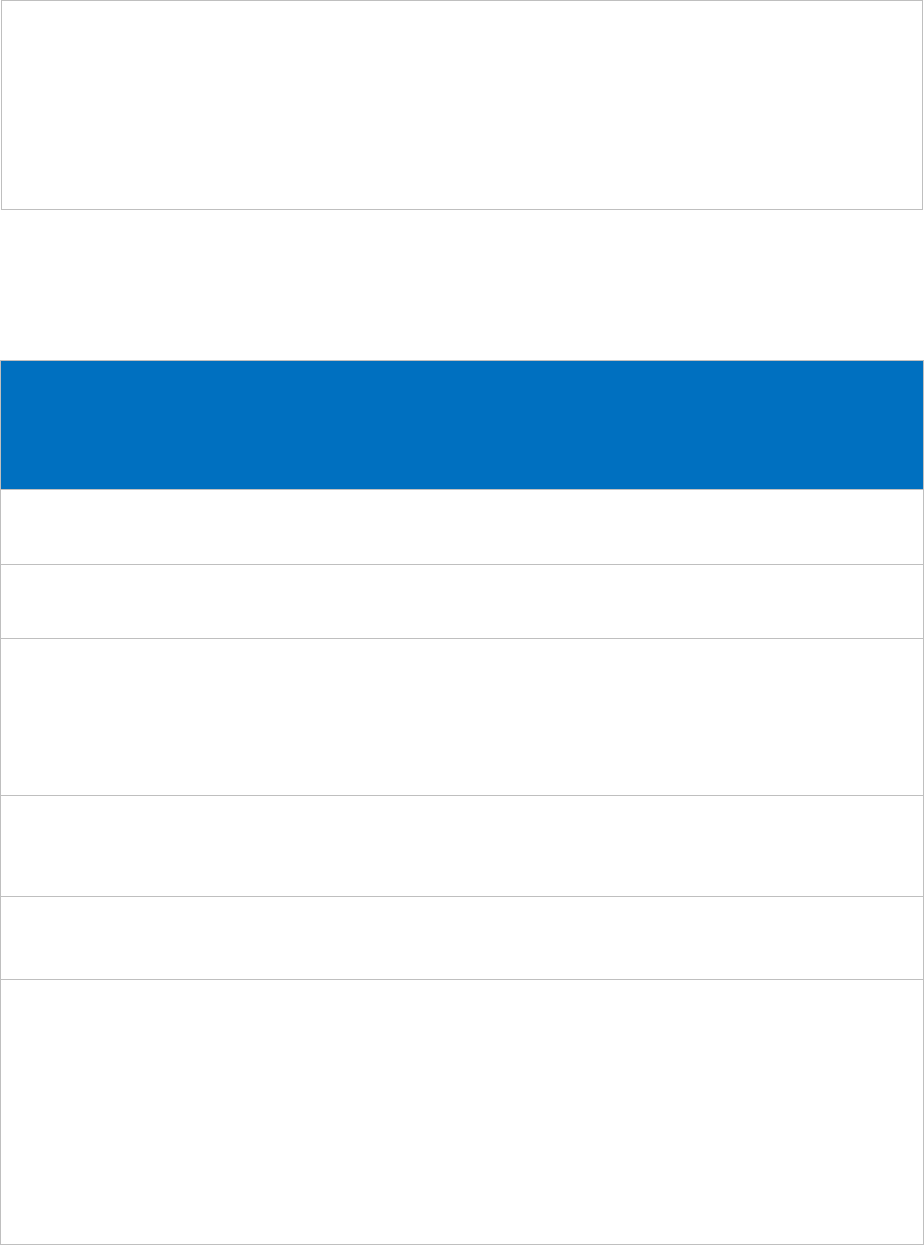
Liberia National Malaria Social and Behavior Change Strategy 2021-2025
15
Gender: Service providers should treat caretakers with respect regardless of age or gender (a young
unaccompanied mother should be treated the same as other couples). A woman's requests and
feelings should be given the same importance as a man’s. Service providers should feel empowered
to conduct testing, regardless of gender dynamics between them and their supervisors and patients.
All patients, irrespective of their gender and geographical location should be tested once suspected
of malaria. Patients should also be informed that malaria tests are free at public facilities and
provided at a cost at private facilities.
Table 4: SBC Behavioral Objective 3- By 2025, 90% of caregivers of children under five are accessing approved anti-malarials
from accredited health facilities (public/ private/ medicine stores).
SBC Behavioral Objective 3
By 2025, 90% of caregivers of children under five are accessing approved anti-malarials from
accredited health facilities (public/ private/ medicine stores).
Primary audience: Caregivers of young children who receive a parasitological confirmation for
malaria (specifically, mothers, fathers, grandmothers, school-age children)
Secondary audience: Screeners, Dispensers, CHAs/ CHVs, CHSS
Communication Objective 1: Increased percentage of community members who know the
importance of taking quality first-line anti-malarials
Communication Objective 2: Increased percentage of caregivers who access approved anti-malarials
from accredited health facilities (hospitals, health centers, clinics, pharmacy, and medicine stores)
Key benefit: Children will receive the appropriate treatment for malaria, increasing outcomes like
child survival. Clients will be happy as the medications will have the desired outcome. These benefits
will lead to increased satisfaction, trust in health facilities and the health system.
Supporting points: Caregivers want to provide their families with the best treatment available. Using
quality medications will help their family members regain their health.
Channels/ Activities:
• Community: Community outreach, including community drama, Video Clubs, advocacy and
sensitization meetings, town halls, town criers, marketplaces, and dialogues; Faith and
community leaders
• Service: Health talks; Service providers; Job aids; Pre-service and in-service training
• Mass media: Umbrella media campaign; Radio; Print; Testimonials; SMS; Social media
platforms

Liberia National Malaria Social and Behavior Change Strategy 2021-2025
16
• Cues to action
Gender: Caregivers should feel empowered to access appropriate treatment, regardless of gender.
Caregivers should follow the full course of appropriate treatment and be linked to recognized health
facilities, pharmacies, and medicine stores that stock quality assured anti-malaria drugs. All patients,
irrespective of their sex and geographical location, will have access to treatment. Patients will also be
told that malaria treatment provided at public facilities is free and at a cost at private facilities.
Providers should treat all caregivers and patients the same regardless of gender or age.
Integrated Vector Management
At a glance: To achieve universal coverage of malaria preventive interventions, the NMCP will increase
household access, coverage, and use of ITNs, and maintain adequate ITNs stock at health facilities
through mass distribution campaigns every three years, routine distribution at ANC facilities, and
institutional distribution through health facilities, schools, orphanages, barracks, and other strategic
locations. In addition, the program will seek inter-sectoral collaboration with relevant actors to achieve
impact.
Subject to the availability of funds and in line with the National Policy and Strategic Plan on IVM 2019 -
2025, indoor residual spraying (IRS) will be implemented in targeted areas with high prevalence as per
the malaria epidemiological profile. The NMCP will advocate and collaborate with local and international
partners and mobilize funds for IRS. IRS will use only insecticides on the WHO prequalified list that
shows acceptable susceptibility for malaria vectors in Liberia.
ITNs can kill night-biting mosquitoes. In addition, IRS can provide extended protection against malaria.
SBC approaches will focus on increasing demand for integrated vector control interventions while
addressing gaps in the use and care of ITNs.
Insecticide-Treated Nets (ITNS)
Current Situation
As a preventive measure, the use of insecticide-treated nets is the core intervention in Liberia. The LMIS
2016 found that among women who have heard of malaria and who say there are ways to avoid getting
malaria, 88.2% cited bed nets as a specific way to avoid malaria. Notwithstanding the high awareness of
the importance of net use, there is room to increase net access and ownership.
Since 2015, the country has conducted three mass distribution campaigns of over 5 million nets
nationwide. In Liberia, net use among those with access to a net is high (98%, LDHS 2019-2020).
According to the Liberia Demographic and Health Survey (LDHS-2019) household, ITN ownership is 55%,
dropping 62% in the 2016 Liberia Malaria Indicator Survey (LMIS). ITN coverage of a net for every two
persons is currently estimated at 25% following the 2018 mass distribution campaign (LDHS 2019).
Access, which dropped from 42% in 2016 to 40% in 2019, is likely to have improved due to the 2021
mass distribution campaign (which ended in July 2021).
Figure Liberia ITN Use

Liberia National Malaria Social and Behavior Change Strategy 2021-2025
17
Previously, reasons for not having access to an ITN
included households not registered, limited access to
ITN distribution locations (e.g long distances). The
timing between household registration and net
distribution also emerged as a contributing factor, as
vouchers went missing or household members
relocated. Additional challenges with net access
include damage to the nets. They are at times lost or
thrown out.
Studies have shown very high knowledge of malaria
amongst the general population, particularly ITN as a
key preventive measure. Knowledge of ITN as the
most effective means of protection against malaria is
high at 88% (LMIS-2016). However, despite high
knowledge of the benefits of net use, several
perceptions negatively impact ITN use, including:
• Nets are too hot and skin burn/irritation: Low
utilization of net among the population is also
attributed to the complaint by some that the net is too
hot to sleep under, while others complain of skin
burn/irritation when they sleep under the net.
• Nets are stored away: Importantly, some
households reported having more nets, some stored away for the future. This finding is an
indication that some households have more nets than needed while others report having less
than they need.
More information is needed on knowledge related to household care of ITNs. When households receive
nets, the suggested actions each household should take include households should hang ITNs under the
shade to air out for 24 hours, tie up or fold the ITN at daytime to keep it away from dirt, children, and
rodents. When the net is in use, proper care includes washing the ITN with bath soap when dirty and
preventing holes to extend the life of the ITN. Net care and beneficial repurposing of old nets can be
integrated into SBC interventions that promote access to and consistent use of ITNs. Repurposing of old
nets should include using old nets as curtains on windows to serve as physical barriers.
With low access to ITNs, utilization is well below desired coverage (39% for the general population
compared to the 80% target). The 2019-2020 LDHS reports that about 56 percent of children under five
years of age and 53 percent of pregnant women ages 15-49 did not sleep under an ITN the night before
the survey. While evidence of a decline in net ownership and access among the general population is of
concern, all efforts are being made to increase net ownership, access, and use in the population. The
NMCP Strategic Plan (2021-2025) seeks to increase net ownership from 55% in 2019 to 90% by 2025 and
use among children under five and pregnant women from 44% and 47% in 2019 to 80% respectively in
2025. Targets will be achieved through various net distribution channels and mass campaigns supported
by a sustained SBC campaign. In addition, the routine campaign which targets pregnant women
attending ANC visits and facility-based (institutional) deliveries will be expanded to school-based net
distribution.
Figure 1: ITN use in Liberia
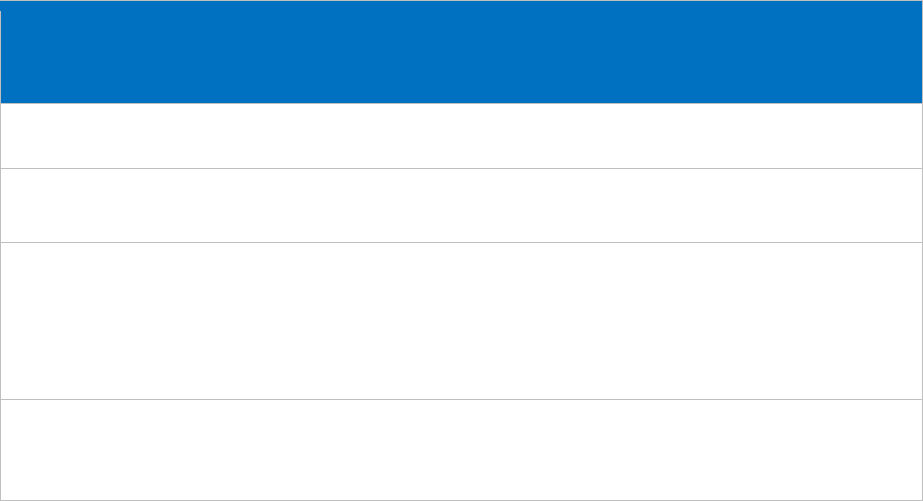
Liberia National Malaria Social and Behavior Change Strategy 2021-2025
18
Audience Analysis
The entire population in Liberia is at risk of malaria. As such, everyone must use ITNs. However, children
under five and pregnant women remain the primary audience for increasing net access, ownership, and
use. Another benefit to increasing net access is that in households with sufficient ITNs, male and female
use of nets is nearly identical. However, in households lacking sufficient nets, males are more likely to
forgo sleeping under the net. Therefore, SBC approaches must target young children's parents (mother
and fathers) to encourage having their children sleep under ITNs to achieve increased access.
Additionally, pregnant women and their spouses/partners must be targeted to ensure that every
pregnant woman believes in the importance of sleeping under an ITN throughout their pregnancy and
with their newborn babies after delivery. While there is no data on the knowledge of spouses/partners
of pregnant women about the danger malaria poses to their pregnant wives/women and unborn child
(this information will be included in the upcoming Malaria Behavior Survey (MBS)), they nonetheless can
support ITN-use. With this knowledge, spouses must support their pregnant partner's desire to sleep
under an ITN everywhere and every night and encourage them to do so.
Service providers (including facility and community-based providers) are often trusted sources of
information and play a key role in educating clients on the importance of sleeping under an ITN
everywhere and every night. They provide information on when, where, and how to use the ITN in their
homes and other places where they sleep. Service providers must provide accurate information on the
key benefits of using the ITN, thereby creating trust and enabling clients to see the benefits of sleeping
under the ITN and promote continuous use amongst families and communities.
Behavior-specific plans
Table 5: SBC Behavioral Objective 4- Increase proportion of the general population with access to ITN to 80% by 2025
SBC Behavioral Objective 4
Increase proportion of the general population with access to ITN to 80% by 2025
Priority Audience: General population
Secondary Audience: Policy Makers (as they need to ensure adequate supplies of ITNs are available
at front-line facilities and in the community), Parents, and Community Leaders.
Communication Objective 1: Increase the proportion of the population who know the steps
necessary to obtain a net
Communication Objective 2: Increased self-efficacy to obtain ITNs (at mass campaigns, ANC
appointments, facility delivery, private sector, or other channels)
Key Benefit: People cannot use a net they do not have access to. Increasing net access should
increase net use, especially in areas where use is high, and access is low. If everyone has access to a
net they can use every night, there will be a reduction in the number of times members of the

Liberia National Malaria Social and Behavior Change Strategy 2021-2025
19
household, especially children and pregnant women, will get sick due to illness from malaria. Less
sickness will enable student household members to remain in school and adults to miss work less
The general population will also benefit as they will spend less on malaria-related expenses. In
addition, fewer missed days from work due to illness might have a more significant economic impact
on the entire household.
Supporting Points: Spending less on child health care saves money to be used for other purposes.
With fewer health facility visits, caregivers have more time to invest in other economic activities.
With healthier children, the caregivers will be viewed favorably by those in their social networks.
Healthy children will regularly attend school and have better focus.
Channels/ Activities:
• Mass Media: Umbrella Media Campaign; Radio, Print, Testimonial, SMS, Social Media
• Schools: School health teachers and/or nurses can also raise awareness of malaria prevention
and treatment issues through class educational activities.
• Mass Campaign: Before distribution efforts, SBC should encourage county engagement
meetings, household registration, raise awareness about the time and location of distribution
points, encourage people to obtain and offer options for replacement of nets either in the
private sector or through routine distribution channels.
• Service: Health talks; Service Providers
• Community: Community outreach, including community drama, Video Clubs, advocacy and
sensitization meetings, town halls, town criers, marketplaces, and dialogues; Faith and
community leaders
• Cues to action
Gender: Specific programs will be developed targeting heads of households to help promote efforts
to secure nets for their households. SBC interventions should consider modeling examples of men
and women making decisions together or discussing decisions. Examples include showing images of
men and women involved in proper net use and care; radio spots of men and women discussing the
importance of using nets; images of a family sleeping under a net can depict a man, woman, and
child sleeping under the net; men can be shown helping to hang the net.

Liberia National Malaria Social and Behavior Change Strategy 2021-2025
20
Table 6: SBC Behavioral Objective 5- Increase the number of children under five who sleep under ITNS to 80% by 2025
SBC Behavioral Objective 5
Increase the number of children under five who sleep under ITNS to 80% by 2025
Primary Audience: Caregivers (mothers, fathers, grandmothers, older school-age children)
Secondary Audience: Older Children, CHAs/ CHVs
Communication Objective 1: Increase the proportion of heads of households (and the general
population) who perceive their children as at risk of malaria if they do not sleep under an ITN year-
round.
Communication Objective 2: Increase perceived response-efficacy of ITNs among caregivers of
children under five
Key Benefit: Children under-five who sleep under an ITN can avoid complications due to malaria.
The burden of malaria among children under five will reduce, avoiding preventable disease and
death.
Supporting Points: Preventing malaria in young children reduces the burden on an overburdened
health system.
Channel/ Activities:
• Mass Media: Umbrella Media Campaign; Radio, Print, Testimonial, SMS, Social Media
• Schools: School health teachers and/or nurses can also raise awareness of malaria prevention
and treatment issues through class educational activities.
• Mass Campaign: Before distribution efforts, SBC should encourage county engagement
meetings, household registration, raise awareness about the time and location of distribution
points, encourage people to obtain and/or offer options for replacing nets either in the private
sector or through routine distribution channels.
• Service: Health talks; Service Providers; Pre-service and in-service training
• Community: Community outreach, including community drama, Video Clubs, advocacy and
sensitization meetings, town halls, town criers, marketplaces, and dialogues; Faith and
community leaders
• Cues to action
Gender: Specific programs will be developed targeting men to support net use in their families. SBC
interventions should consider modeling examples of men and women making decisions together or
discussing decisions. Examples include showing images of men and women involved in proper net
use and care; images of a family sleeping under a net can depict a man, woman, and child sleeping
under the net; men can be shown helping to hang the net or attending ANC with their partners.

Liberia National Malaria Social and Behavior Change Strategy 2021-2025
21
Table 7: SBC Behavioral Objective 6- Increase practice of correct and consistent net use among the general population to 65% by
2025
SBC Behavioral Objective 6
Increase practice of correct and consistent net use among the general population to 65% by 2025
Priority Audience: General population
Service Providers (facility and community based)
Communication Objective 1: Increased proportion of the population who encourage their friends
and family to sleep under an ITN
Communication Objective 2: Increased proportion of the population who feel confident in their
ability to sleep under an ITN every night
Key Benefit: Used consistently, you can sleep easy knowing you are protected from malaria and that
your family is protected and healthy
Supporting Points: If the whole community uses nets consistently, mosquitos will have difficulty
feeding and reproducing.
Channels/ Activities:
• Mass media: Umbrella media campaign; Radio; Print; Testimonials; SMS; Social Media
• Community: Community outreach, including community drama, Video Clubs, advocacy and
sensitization meetings, town halls, town criers, marketplaces, and dialogues; Faith and
community leaders
• Mass Campaign: Before distribution efforts, SBC should encourage county engagement
meetings, household registration before distributions, raise awareness about the time and
location of distribution points, encourage people to obtain and/or replace nets either in the
private sector or through routine distribution channels like ANC.
• Services: Health talks; Service providers
• Schools: School health teachers and/or nurses can also raise awareness of malaria prevention
and treatment issues through class educational activities
• Cues to action
Gender: Male engagement activities will be developed targeting men to help encourage their
support of the use of ITNs. SBC interventions should consider modeling examples of men and
women making decisions together or discussing decisions. Examples include showing images of men
and women involved in proper net use and care; images of a family sleeping under a net can depict a
man, woman, and child sleeping under the net; men can be shown helping to hang the net or
attending an ANC with their partners.

Liberia National Malaria Social and Behavior Change Strategy 2021-2025
22
Indoor Residual Spraying (IRS)
Current Situation
Indoor residual spraying (IRS) is an effective intervention for malaria control and elimination efforts. IRS
works by reducing the lifespan of adult mosquitoes that comes in contact with a sprayed surface.
Regular IRS is shown to be effective when there is high coverage of at least > 85% of all structures that
are potential resting places for mosquitoes.
10
. As a result, it is critical to apply IRS in a targeted manner
within the broader context of the national malaria control efforts.
The reintroduction of IRS in Liberia was facilitated by PMI, which implemented the Africa Indoor
Residual Spraying project from 2009-2013 in selected districts in five counties, namely: Margibi,
Montserrado, Bong, Grand Bassa, and Nimba. The districts where IRS was conducted were selected
based on Liberia's strategic approach to prioritize communities with high malaria burdens.
A lack of trust previously affected the IRS intervention when it was first introduced. Despite the
hesitation from communities, IRS was conducted for three years, and communities have been inquiring
about it in recent years and would like to see it return to Liberia. The National Strategic Plan 2021-2025
includes IRS as a critical strategic approach and aims to have at least 85% of the population in targeted
districts protected by IRS y 2025. The WHO recommends targeted spraying of focal points with high
malaria transmission as an effective vector control strategy to reduce malaria cases.
Acceptance among community members is a key factor in determining the success of IRS campaigns. In
previous campaigns, the reluctance of the heads of households and others in the community to willingly
participate or cooperate with an IRS exercise was influenced by misconceptions and /or poor
understanding about the intervention.
Audience Analysis
The primary audience for SBC efforts related to IRS is heads of households and caregivers, as they are
primarily responsible for the health of their households and are the primary decision-makers for the
household. These groups need to be home to allow entry to sprayers and rearrange the household items
for the IRS to take place. The heads of households would also need to ensure that no one washes,
paints, or replasters the walls after spraying.
A secondary audience would be community leaders and influencers that are important for facilitating
community support, which is essential for the overall success of IRS campaigns. Community Leaders and
other household members can encourage relocation of household items and tolerance of side effects
(e.g., spray odor). They can also help generate community trust and buy-in, thereby allowing heads of
households and decision-makers to be more open and accepting of the intervention. Spray teams are
also influential as they provide relevant information before, during and after spraying. If IRS moves
10
WHO 2015: Indoor residual spraying: an operational manual for indoor residual spraying (IRS) for malaria transmission control and
elimination – 2nd ed.

Liberia National Malaria Social and Behavior Change Strategy 2021-2025
23
forward in Liberia, additional research and focus on the interpersonal communication skills of the
sprayers may be worthwhile.
Behavior-specific plan
Table 8: SBC Behavioral Objective 7- Increase the proportion of households that cooperate with spray operators and follow pre-
and post- spray guidelines given by spray personnel to 80% by 2025.
SBC Behavioral Objective 7
Increase the proportion of households that cooperate with spray operators and follow pre-and post-
spray guidelines given by spray personnel to 80% by 2025.
Primary Audience: Heads of Households, Caregivers
Secondary Audience: Community Leaders
Communication Objective 1: Reduce the proportion of heads of households who express fear or
misconceptions about chemicals used for the IRS.
Communication Objective 2: Increase the proportion of heads of households that express
acceptance and trust of IRS being used in their homes.
Key Benefit: Malaria is prevented, and the family is healthy. If the family accepts IRS, they will save
money by not spending out-of-pocket to buy insecticides or miss work due to illness from malaria.
Supporting Points: IRS spraying takes only a day and lasts for up to four months, depending on the
efficacy of the insecticide used. It kills mosquitoes as well as other insects. The family has good social
standing for being healthy in the community.
Channels/ Activities:
• Community: Advocacy and town hall meetings; Door-to-door mobilization; Faith and community
leaders
• Mass Media: Mass media (radio)
• Cues to action
Gender: The decision to allow sprayers will likely be made by the head of the household. SBC
interventions should encourage couple's communication about the decision-making about spraying
the house. Sometimes, sprayers will come when the male head of the household is away, and a
female may not feel empowered to let strangers into the house. Also, moving the furniture may be
seen as a man’s role, so his approval is important.

Liberia National Malaria Social and Behavior Change Strategy 2021-2025
24
Malaria in Pregnancy
At a glance: Malaria in pregnancy is a cross-cutting issue involving coordination among various partners.
SBC activities to support interventions focus on addressing gaps in obtaining three or more doses of
intermittent preventive therapy (IPTp3), in line with Liberia's newly updated National Guidelines for
Malaria in Pregnancy (2021).
Current situation
IPTp3 trends indicate an increase from 11% in 2011 to 23% in 2016 and now 40% in 2019 (2019-20 DHS),
but progress is still needed to achieve the 80% target set by the Malaria National Strategic Plan 2021-
2025.
According to results from the National Malaria Control Program health facility survey (2018), malaria
was responsible for 57.3% of morbidity in pregnancy. However, most pregnant women are not receiving
the recommended minimum 3+ doses for IPTp for malaria prevention, in part due to factors such as
declines in ANC attendance from the first to the fourth visit. According to the LDHS 2019-2020, the
percentage of women receiving one or more doses of IPTp increased from 58% in 2009 to 90% in 2019-
20, while the percentage receiving two or more doses increased from 47% to 70%. The LDHS 2019-2020
also notes a decline in rates from 90% for IPTp 1 to 70% for IPTp 2 and 40% for IPTp3+. Therefore, the
Malaria Strategic Plan aims for at least 80% of pregnant women (disaggregated by age) to use ANC
services to be protected with appropriate IPTp3+ doses during pregnancy. However, a 2019 LDHS also
showed that only 40% of pregnant women took at least three doses of IPTp. In 2016, 45% did not take
IPTp at all because of its perceived side effects.
Given the very high ANC rates across Liberia, 3+ doses of IPTp should be higher if delivered consistently.
However, the current low rates of IPTp3 coverage suggests that facility level challenges, failure to
administer IPTp, and/or issues with ANC registration may have a role to play. Another factor potentially
contributing to the gap between IPTp1 and IPTp 3 could be that service providers do not routinely
provide comprehensive information (including purpose, timing, side effects, and benefits) about malaria
at ANC due to heavy workloads. The limited available data on this topic requires further research to
inform the strategy to address providing comprehensive information on IPTp during ANC visits.
The NMCP and its partners will liaise with the Family Health Division, National Health Promotion Unit,
and Ministry of Gender, Youth and Sports to leverage existing gender-responsive and youth-friendly SBC
activities. These activities will promote health services to benefit women and young girls. In addition,
this strategy will focus on integrating SBC malaria activities into other health services delivery,
particularly (1) mental health, sexual and reproductive health including malaria; (2) innovation and
digital health interventions created with and for adolescent boys and girls.
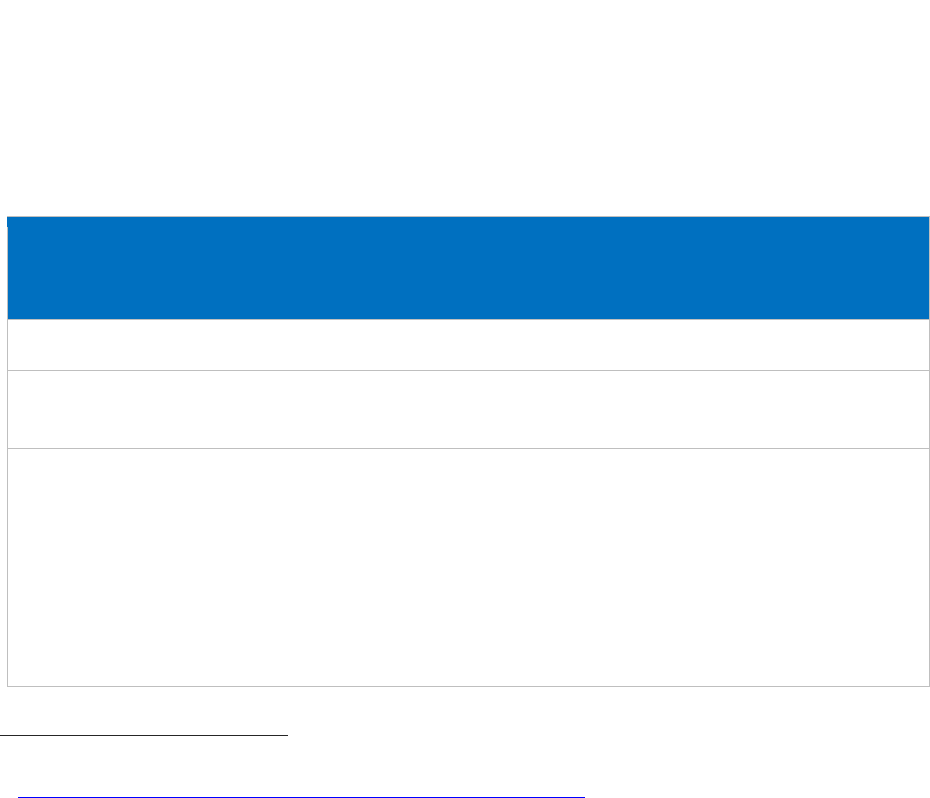
Liberia National Malaria Social and Behavior Change Strategy 2021-2025
25
Audience analysis
The primary audience in Liberia are females of reproductive age, particularly adolescent girls in their
first and second pregnancies, who are vulnerable
11
and may face unique barriers. These barriers include
being frequently unable to access health facilities independently (health worker requiring the presence
of an adult), shame related to their pregnancy, poor adherence, and refusal to access resources often
requiring extensive follow-up from healthcare workers, lack of social support due to the absence of the
fathers of their babies and language barriers at the health facility. Additionally, adolescent girls face
unique barriers in accessing health services that need to be addressed. For example, young pregnant
women, especially first-time mothers, may have limited knowledge about the importance and benefits
of early ANC, IPTp uptake, and consistent net use. According to the 2019-2020 LDHS, 71% of women in
their first trimester of pregnancy attended the first ANC visit. Access for young pregnant girls (15-20
years old) may also have additional financial and social challenges, suggesting a need to encourage
families to continue prioritizing these girls, especially those residing in rural areas.
The secondary audiences are the partner, head of household, and parent/guardian residing in urban and
rural areas are. They play a significant role in helping pregnant women make decisions about their
health and provide financial support. Service Providers play an essential role in providing high-quality
antenatal care, including IPTp. These secondary audiences may help ensure that pregnant adolescents
attend all ANC visits, take at least three doses of IPTp, and adhere to sleeping under treated ITNs.
Behavior-specific plan
Table 9: SBC Behavioral Objective 8- Increase IPT3+ uptake by pregnant women to 80% by 2025.
SBC Behavioral Objective 8
Increase IPT3+ uptake by pregnant women to 80% by 2025.
Primary Audience: Pregnant women and facility-based services providers
Secondary Audience: Mothers, Grandmothers, Aunts, Community Members (TTM, CHAs/ CHVs,
etc.).
Communication Objective 1: Increase the proportion of service providers who feel well-equipped to
provide comprehensive information to pregnant women on the importance of taking IPT3+
Communication Objective 2: Increase the proportion of pregnant women who believe that S.P.
safely prevents the adverse consequences of malaria
Communication Objective 3: Increase self-efficacy of pregnant women to request S.P. during ANC
appointments
11
https://www.who.int/gender/documents/gender_health_malaria.pdf
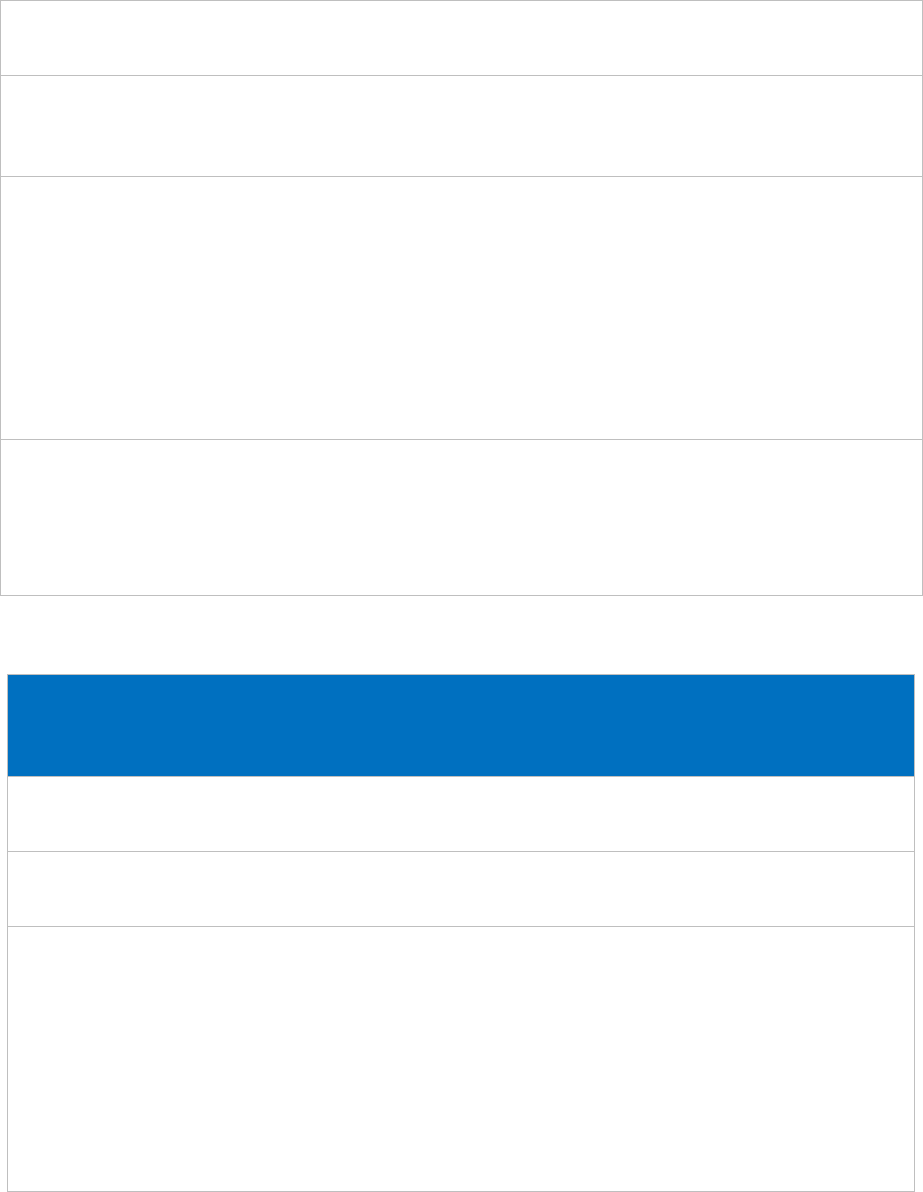
Liberia National Malaria Social and Behavior Change Strategy 2021-2025
26
Key Benefit: IPTp3+ uptake reduces the risk of malaria, thereby increasing the chances of a healthy
pregnancy and a healthy baby.
Supporting Points: Pregnant women who attend all ANC services early and often take 3+ IPTp will
prevent a malaria infection, complication, and intrauterine or maternal death. Fewer malaria cases
will help an overburdened health system better care for pregnant women.
Channels/ Activities:
• Umbrella media campaign; Radio; Print; testimonials; SMS; Social Media
• Community outreach, including community drama, Video Clubs, advocacy and sensitization
meetings, town halls, town criers, marketplaces, and dialogues; Faith and community leaders
• Service providers: Health talk; Job aids; Pre-service and in-service training
• Cues to action
Gender: Pregnant women should be supported by their parent/guardian or partner when visiting a
facility for all ANC visits. Older parents/guardians should help with the financial costs of attending
ANC and provide emotional support to the pregnant adolescent, and encourage her to seek care
early, and where possible, accompany her on ANC visits. Providers should deliver high-quality care,
regardless of the woman’s age and relationship status
Table 10: SBC Behavioral Objective 9- Increase consistent and correct net use by pregnant women to 80% by 2025.
SBC Behavioral Objective 9
Increase consistent and correct net use by pregnant women to 80% by 2025.
Primary Audience: Pregnant women (especially those with high-risk pregnancies such as
adolescent mothers and older mothers)
Secondary Audience: Partner; Parents, Community Members (TTMs, CHAs/CHVs, and Community
Structures), Service Providers
Communication Objective 1: Increase the proportion of pregnant women who perceive
themselves at risk if they do not sleep under an ITN all year round.
Communication Objective 2: Increase the proportion of women who feel confident in their ability
to discuss the benefits of ITN use and care with their spouse
Communication Objective 3: Increase the proportion of providers who feel confident that they can
provide information on the importance of ITNs care and use and distribute ITNs to pregnant
women at ANC clinics and during delivery when ITNs are available at the facility.

Liberia National Malaria Social and Behavior Change Strategy 2021-2025
27
Key Benefit: If pregnant women know the importance of using ITN and are encouraged by their
parent/guardian or spouse to sleep under ITN everywhere and every night, it will prevent malaria
infection during pregnancy, and the mother will have a healthy baby.
Supporting Points: The parent/guardian or spouse would save time and money if they encouraged
the pregnant women to sleep under treated ITN everywhere and every night. This will prevent a
malaria infection, pregnancy complications, and intrauterine or maternal death.
Channels/ activities:
• Community: Community outreach, including community drama, Video Clubs, advocacy and
sensitization meetings, town halls, town criers, marketplaces, and dialogues; Faith and
community leaders
• Services: Health talks; Service providers; Job aids
• Mass media: Umbrella media campaign; Radio; Print; testimonials; SMS messages; Social
Media
• Cues to action
Gender: The parent/guardian or partner should support pregnant women to sleep under treated
ITN everywhere and every night.
All pregnant women should be provided information on the proper use of nets regardless of their
age and relationship status.
Table 11: SBC Behavioral Objective 10- By 2025, increase the % of pregnant girls (aged 10-19) who utilized MIP services to 50%.
SBC Behavioral Objective 10
By 2025, increase the % of pregnant girls (aged 10-19) who utilized MIP services to 50%.
Primary Audience: Pregnant girls (aged 10-19)
Secondary Audience: Partner, Caregivers, Parents, Service Providers, Community Members (TTMs,
CHAs/CHVs, and Community Structures)
Communication Objective 1: Increase the proportion of pregnant girls (10-19) with knowledge of
malaria prevention methods, including MIP services
Communication Objective 2: Increase the proportion of partners/ caregivers who are supportive of
pregnant girls (10-19) utilizing MIP services
Communication Objective 3: Increase the proportion of pregnant girls who believe it is important
to attend ANC as soon as they know they are pregnant.

Liberia National Malaria Social and Behavior Change Strategy 2021-2025
28
Key Benefit: If you utilize MIP services, you will prevent malaria and its complications and have a
healthy pregnancy and healthy baby
Supporting Points: The partner/ caregiver would save time and money if they provided
information to pregnant girls on the importance of utilizing MIP services.
Channels/ activities:
• Mass: Umbrella media campaign; Radio; Print; Testimonials; SMS; Social Media
• Community: Outreach, Faith and Community leaders
• Services: Health talks; Service providers
• Schools: School health teachers / Health Clubs and/or nurses can also raise awareness of
issues related to malaria prevention and treatment through class educational activities.
• Cues to action
Gender: Partner/caregiver should provide information to pregnant girls (10-19) on the importance
of utilizing MIP services and support the uptake of MIP services. This may be difficult due to social
stigma around unwed young girls getting pregnant.
Liberia National Malaria Social and Behavior Change Strategy 2021-2025
29
Monitoring and Evaluation
The design and scope of SBC activities will be informed by data from population-based surveys like
LDHS, LMIS, and malaria behavior surveys; routine information systems like HMIS and CBIS; operational
research, annual knowledge attitude, and practice surveys; and other surveys. Importantly, upcoming
malaria-focused surveys present opportunities to explore gaps in current understanding or evidence
related to malaria prevention and treatment.
Routine /Monthly Monitoring of SBC activities
Monthly monitoring of SBC activities will be tracked using more than one approach. Several malaria-
related accelerator behaviors are currently tracked and reported monthly via the DHIS-2. These include
early care seeking, IPTp3 uptake, and prompt ACT treatment.
There is a need to include other malaria-related SBC indicators to complement what is currently being
tracked through the monthly DHIS-2 reporting. For example, exposure to malaria messages, knowledge
and use of bed nets, and specific malaria-related behavior amongst households-self-efficacy. Based on
the concentration of where these behaviors are triggered and practiced, routine quarterly monitoring
will involve staff from the county health team, district health team, facilities, and community members
who are caregivers and community health workers.
Measuring and reporting the exposure to malaria messages, knowledge, and self-efficacy amongst
households quarterly, has a huge attribution to other health accelerator behaviors and will contribute to
designing high-quality, data-informed SBC activities. Additionally, it will help to assess attitudes and
norms towards using ITNs and other malaria preventive behaviors inclusive of gender.
The tables below outline the behavioral and communication objectives, as well as details on planned
monitoring efforts:
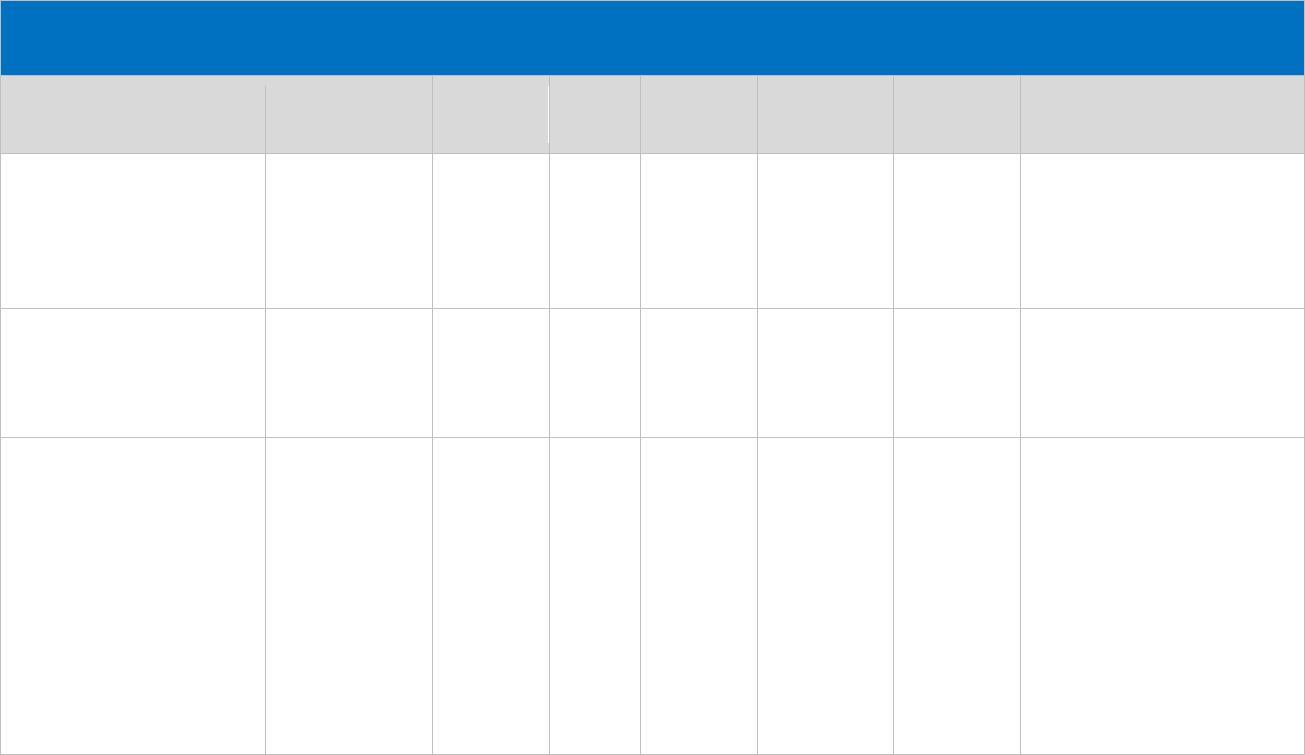
Monitoring and Evaluation Plan
Table 12: M&E Plan - Malaria Case Management
Malaria Case Management
Indicator and Definition
Indicator Type
Rationale
Data
Source
Baseline
Baseline
year
Target
(2025)
Notes
Proportion of children
under-five with fever and
diagnosed with malaria for
whom care is sought
within 24 hours
Behavior
objective
Priority
Behavior
MIS,
DHS
32%
2019-2020
75%
This can be tracked through
the CBIS, HMIS.
Proportion of people who
take malaria treatment
only after testing positive
for malaria
Behavior
objective
Priority
Behavior
MBS
To be added in other
population-based survey
(LDHS, MIS)
Proportion of service
providers who support
testing before treating
Communication
objective
Priority
Behavior
CBIS
MBS
92%
This is
based on
the
current
reduction
of clinical
malaria
diagnosis
2021
100%
Track through DHIS-2

Liberia National Malaria Social and Behavior Change Strategy 2021-2025
31
Malaria Case Management
Indicator and Definition
Indicator Type
Rationale
Data
Source
Baseline
Baseline
year
Target
(2025)
Notes
Proportion of service
providers who conduct
testing before treating
Behavior
objective
Priority
Behavior
CBIS
HMIS
MBS
92%
This is
based on
the
current
reduction
of clinical
malaria
diagnosis
2021
100%
Track through DHIS-2 and
MBS
Proportion of service
providers who have a
favorable attitude towards
administering ACT only for
confirmed malaria cases
Provider
behavior
objective
Ideational
factor/
service
providers
HMIS
68%
2020
93%
Continue tracking through
DHIS-2.
Proportion of caregiver of
children under five years
old with fever and
diagnosed with Malaria in
the last two weeks for
whom advice or treatment
is sought
Behavior
objective
Health
seeking
behavior
MIS,
DHS
81%
2019-2020
91%
Track through MBS
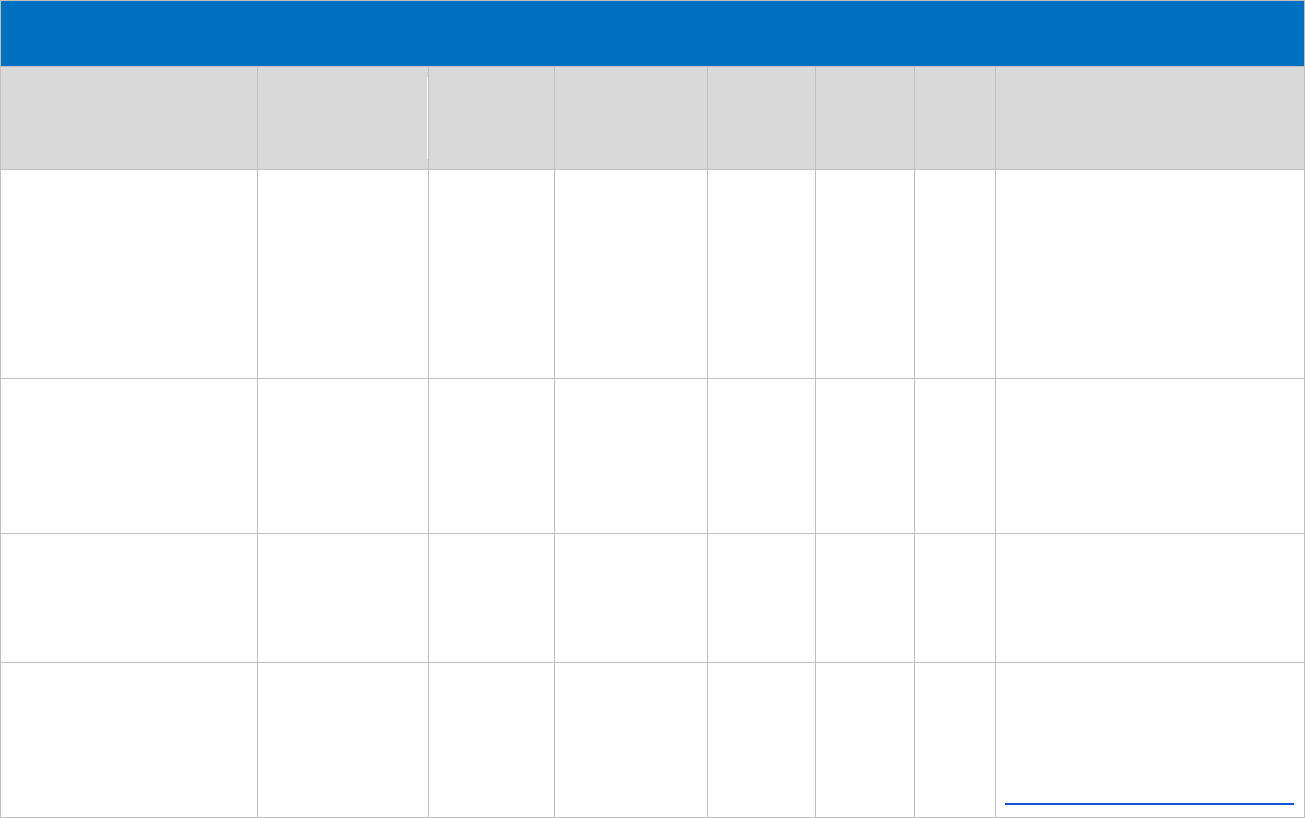
Liberia National Malaria Social and Behavior Change Strategy 2021-2025
32
Table 13: M&E Plan - Insecticide-Treated Nets (ITN)
Insecticide-Treated Nets (ITN)
Indicator and Definition
Indicator Type
Rationale
Data Source
Baseline
Baseline
year
Target
(2025)
Next steps
Proportion of people that
believe the majority of
their friends and
community sleep under
an ITN
Communication
objective
Net use
DHS
MIS, MICS,
MBS
65%
Include this indicator in the
MBS questionnaire. Currently,
there is no baseline data for this
indicator. However, there will
be an MBS conducted by the
end of this year and will provide
baseline data.
Proportion of people who
know the use of ITN as a
preventive measure
against malaria
Communication
objective
Knowledge
MIS, MBS
88%
2016
95%
Include this indicator in the
MBS questionnaire. This can
also be found in the post
distribution survey report of
2018
Proportion of the
population that slept
under an ITN the previous
night before the survey
Behavior
objective
Priority
behavior
MIS, DHS
39%
2016
65%
This is included in the MBS
Proportion of the
population with access to
an ITN within their
household the night
before the survey.
Behavior
objective
Priority
behavior
DHS
25%
2019
100%
Breakthrough ACTION routinely
tracks and reports on this
indicator based on the latest
demographic surveys:
https://breakthroughactionandr
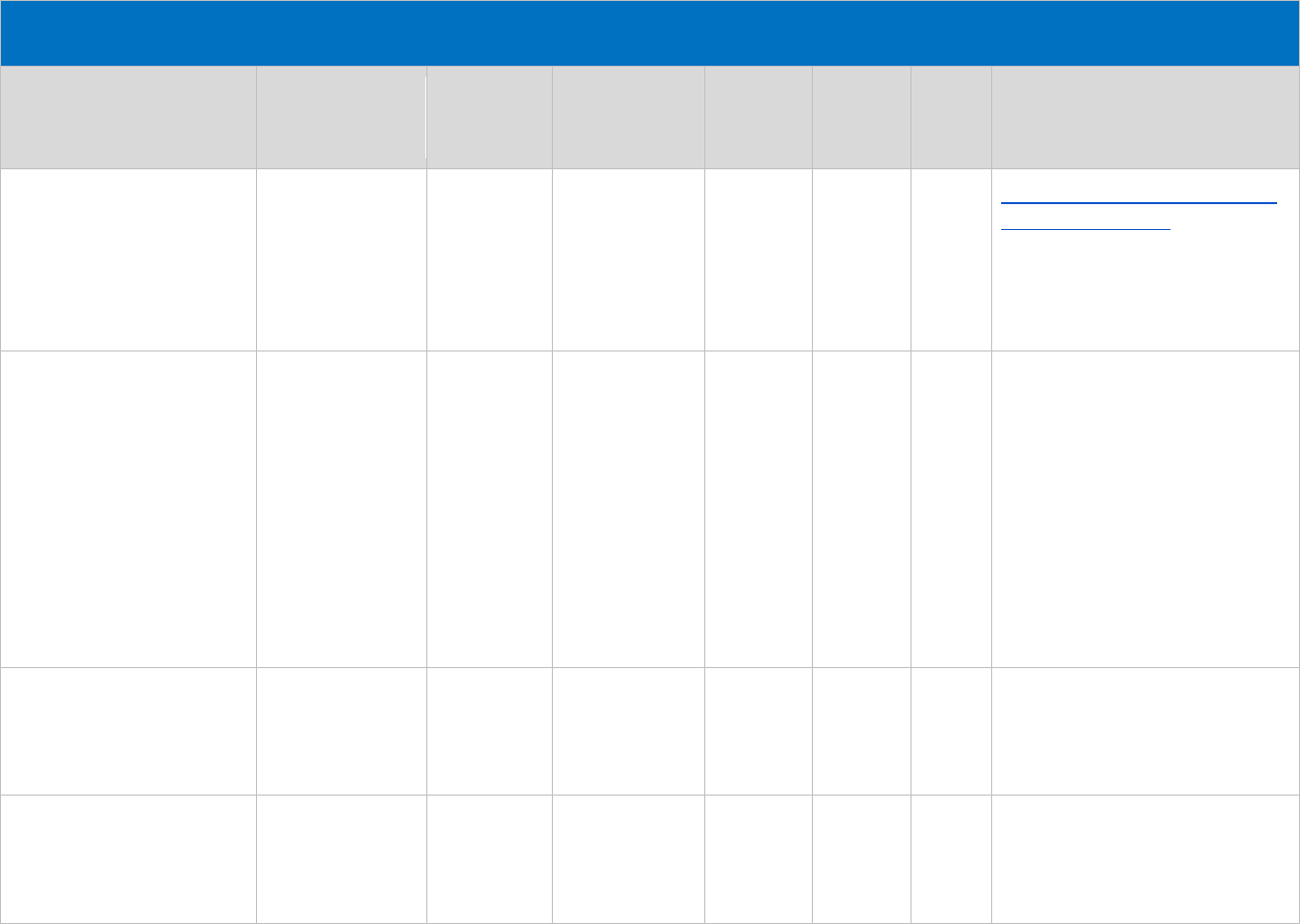
Liberia National Malaria Social and Behavior Change Strategy 2021-2025
33
Insecticide-Treated Nets (ITN)
Indicator and Definition
Indicator Type
Rationale
Data Source
Baseline
Baseline
year
Target
(2025)
Next steps
esearch.org/resources/itn-use-
and-access-report/ This will be
reported as well from the
upcoming MIS
Proportion of people who
believe that ITN use
reduces their risk of
getting malaria
Communication
objective
Ideational
factor
Attitudes,
Beliefs and
Practices
Relevant to
Malaria
Prevention
and
Treatment in
Liberia 2014
MBS
85%
2021
95%
This could be included in the
MBS
Proportion of children
under five who slept
under an ITN the previous
night before the survey
Behavior
objective
Priority
behavior
MIS, DHS,
MICS
44%
2020
80%
This will be captured in the
2022 LMIS
Proportion of pregnant
women who slept under
an ITN the previous night
before the survey
Behavior
objective
Priority
behavior
MIS, DHS,
MICS
47%
2020
80%
This will be captured in the
2022 LMIS

Liberia National Malaria Social and Behavior Change Strategy 2021-2025
34
Table 14: M&E Plan - Indoor Residual Spraying (IRS)
Indoor Residual Spraying
Indicator and Definition
Indicator Type
Rationale
Data
Source
Baseline
Baseline
year
Target
(2025)
Next steps
Proportion of people
who understand the
benefits of IRS
Communication
objective
Knowledge
TBD
TBD
TBD
Proportion of people
with a favorable attitude
towards IRS
Communication
objective
Ideational
factor
TBD
TBD
TBD
Table 15: M&E Plan - Malaria in Pregnancy
Malaria in Pregnancy
Indicator and Definition
Indicator Type
Rationale
Data
Source
Baseline
Baseline
year
Target
(2025)
Next steps
Proportion of adolescents
(10-19yrs) with knowledge
of malaria prevention
Communication
objective
Knowledge
MIS,
LDHS
0
2021
50%
This can be tracked through
the MIS and LDHS
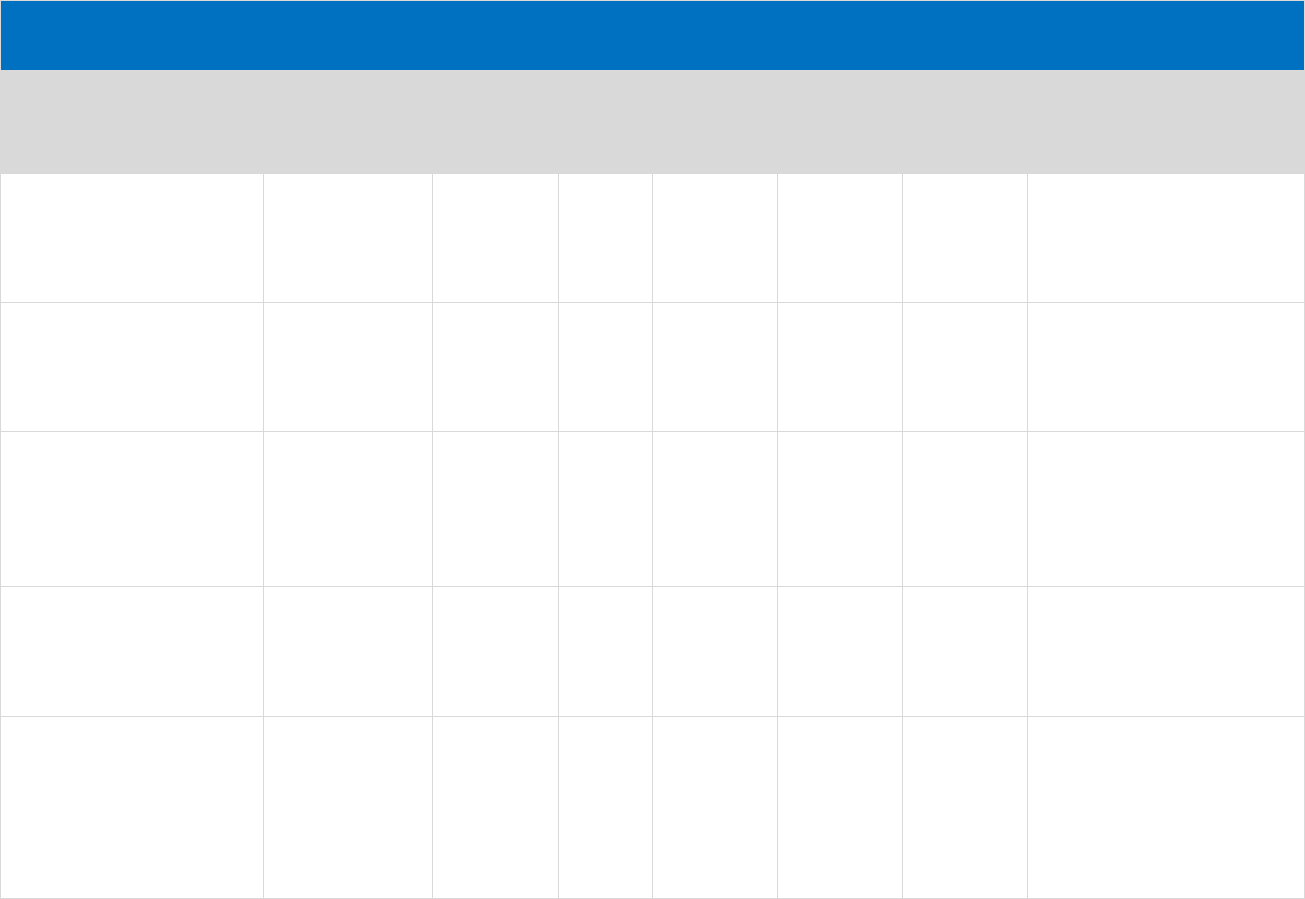
Liberia National Malaria Social and Behavior Change Strategy 2021-2025
35
Malaria in Pregnancy
Indicator and Definition
Indicator Type
Rationale
Data
Source
Baseline
Baseline
year
Target
(2025)
Next steps
Proportion of adolescent
girls (10-19 yrs) who sleep
under ITN the night before
the survey
Behavior
objective
Priority
behavior
MIS,
LDHS
0
2021
50%
This can be tracked through
the MIS and LDHS
Proportion of pregnant
women at ANC that took
3+ doses of IPTp according
to national guideline
Outcome
Priority
Behavior
HMIS
MIS,
DHS
49%
2020
74%
Continue to track through
DHIS-2; Include in MBS
Proportion of pregnant
girls (10-19 years) at ANC
that took 3+ doses of IPTp
according to the national
guideline
Behavior
objective
Priority
behavior
HMIS,
MIS,
LDHS
0
2021
50%
This can be tracked through
the HMIS, MIS, and LDHS
% Of pregnant women
given nets during ANC1
Provider
behavior
objective
Priority
Service
Delivery
Behavior
HMIS
71%
2020
96%
Include in LMIS
Track in DHIS-2
Proportion of pregnant
women with fever and
diagnosed of Malaria in
the last two weeks for
whom advice or treatment
is sought
Behavior
objective
Priority
Service
Delivery
Behavior
MIS,
LDHS
81%
2019-2020
91%
Track through MBS
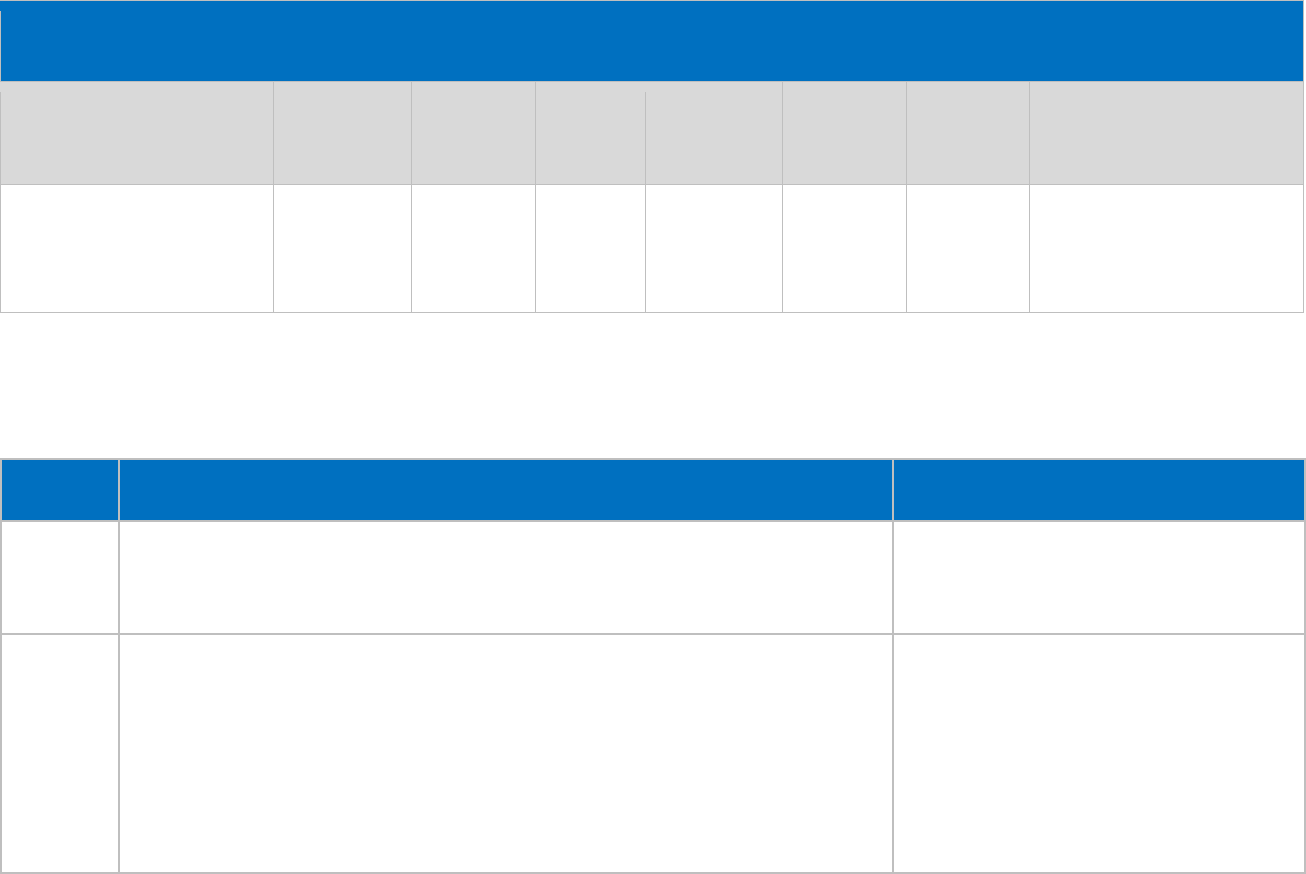
Liberia National Malaria Social and Behavior Change Strategy 2021-2025
36
Table 16: M&E Plan - Cross Cutting Issues
Cross-cutting
Indicator and Definition
Indicator
Type
Rationale
Data
Source
Baseline
Baseline
year
Target
(2025)
Next steps
Proportion of males who
are involved in their
partners health decision
making
Behavior
objective
Priority
behaviors/
Gender
MIS,
LDHS
0
2021
50%
This will be included in the
upcoming MIS and LDHS
Current Gaps in Existing SBC Data
Table 17: Current Gaps in Existing SBC Data
Topic
Data Gaps Observed
Future Opportunities to Obtain SBC Data
SSSFC
• Prevalence of sub-standard, spurious, falsely labeled, falsified, and counterfeit
(SSFFC) anti-malarial drugs
IRS
• Percent of households that cooperate with IRS spray operators and had their
houses sprayed
• Proportion of households reporting relatively low mosquito infestation after
being sprayed
• Percent of community influencers who facilitated community support for the
overall success of the IRS campaign.
Gather all knowledge and perception data
about IRS amongst households

Liberia National Malaria Social and Behavior Change Strategy 2021-2025
37
Annex A: Pathways Model
Context
• Year-round malaria
transmission (which peaks
during rainy season)
• NHPU coordination for SBC
• CHSD services
implementation
• Partner-funded
programming
• COVID-19 Pandemic
Service
Delivery Resources
• Commodities (provisions of
ITNs)
• Human resources
• Financial resources
Community Resources
• Funding for services/
commodities
• NMCP SBCC unit SBCC
implementation
• National Malaria Strategic
Plan (updated 2020)
• National Malaria SBC
Strategy (updated 2021)
• Community Health Services
Policy (updated 2021)
• Emergency Preparedness
Supportive Environment
• Multi-sectoral partnerships
• Public opinion
• Institutional performance
• Resource access
• Media support
• Activity level
Service Performance
• Access to ITNs, mRDTs, ACTs, S.P.
• Quality of services
• Correct diagnosis
• Correct treatment
• Provision of S.P.
• Client satisfaction
Community
• Improved vector control
• Leader advocacy for malaria
prevention and resource allocation
Individual
• Prompt test seeking for fever
• Consistent ITN use
• Care and repair of ITNs
• Adherence to ACT prescription
instructions (completing the full
course)
• Regular ANC attendance
• Demand S.P. at every ANC visit after
first trimester
• Demand ITNs at first ANC visit and at
institutional delivery
• Cooperate with IRS sprayers
Underlying Conditions
Domains of Communication
Initial Outcomes
Behavioral Outcomes
Service Systems
Community
Individual
Environment
Socio-political Environment
• NMCP/NCHP/ NHPU
integration
• NMCP policy guidelines for
ITNs, MIP, CM
• NHPU
• SBC advocacy activities
• Gender Integration
Coordination
• SBCC resource allocation
• SBCC capacity strengthening
Health providers
• Provision of ITNs, mRDTs, ACTs,
sulphadoxine-pryimethamine (S.P.)
• Adherence to national guidelines for
testing, treatment, and spraying
• Interpersonal communication and
counseling skills
• Integration of services between CHSD,
NHPD, and NMCP
• Health Quality Control Unit
Community
• Culture of net use
• Testing before treatment
• Community support for early and regular
antenatal care (ANC) groups
• Women’s groups, civic-based
organizations, faith-based organizations
encourage open discussion about
preventing malaria in pregnancy
Individual
• Exposure to SBCC
• SBCC activity reach
• Message recall
• Perceived social support for attending ANC
• Increased self-efficacy to obtain and sleep
under ITNs
• Perceived social support for IRS
• Perceived threat of malaria
• Awareness of mRDT and ACT availability in
private sector
Service Delivery
• Health promotion capacity
strengthening for county,
district, and community
level officials and CHAs,
CHVs
• Program integration
• ITNs distributed in 2018,
MRDTs re-introduced in
2015 and scaling up, ACTs
available and subsidized
Community
• Radio, Television
• Information
Communication Technology
(SMS, IVR)
• Social mobilization
• Interpersonal
communication
• Media campaigns
• Private sector involvement
• School programs
Adapted from Kincaid, Figueroa and Underwood
